Forums
- Forums
- Duggy's Reference Hangar
- USAAF / USN Library
- Lockheed Starfighter
Lockheed Starfighter
Post a reply
- Go to Previous topic
- Go to Next topic
- Go to Welcome
- Go to Introduce Yourself
- Go to General Discussion
- Go to Screenshots, Images and Videos
- Go to Off topic
- Go to Works in Progress
- Go to Skinning Tips / Tutorials
- Go to Skin Requests
- Go to IJAAF Library
- Go to Luftwaffe Library
- Go to RAF Library
- Go to USAAF / USN Library
- Go to Misc Library
- Go to The Ops Room
- Go to Made in Germany
- Go to Campaigns and Missions
- Go to Works in Progress
- Go to Juri's Air-Raid Shelter
- Go to Campaigns and Missions
- Go to Works in Progress
- Go to Skinpacks
- Go to External Projects Discussion
- Go to Books & Resources
-
5 years agoMon Nov 30 2020, 03:56pm
 Main AdminCanadian Starfighters
Main AdminCanadian Starfighters
A modified ex-USAF F-104A was supplied to Canadair as an initial pattern aircraft for CF-104 production. The type was originally designated the "CF-111" and had the company designation of "CL-90". Deliveries of the CF-104 began in 1961, with the first rolled out on 18 March 1961 and performing its first flight from Palmdale, California, ten days later. A total of 200 CF-104s was built for the RCAF, and except for an operational conversion unit at Cold Lake, Alberta, they were all used in Europe as part of Canada's NATO commitment.
The CF-104 was almost identical to the F-104G. It was powered by the J79-OEL-7 turbojet, a J79-GE-7A built under license by Orenda of Canada. CF-104s were originally tasked with the nuclear strike role; the Vulcan cannon and gunsight were not fitted. These aircraft were converted to the tactical strike role in the early 1970s, to be refitted with the Vulcan cannon and gunsight. External ordnance for tactical strike included dumb bombs, CRV 70 unguided rocket pods, and the British Hunting Engineering BL755 cluster bomb.
Since CF-104Ds were intended as strike aircraft, they used the R24A version of the NASARR radar that deleted air-to-air capability. Some CF-104s were wired to carry a Vinten conformal reconnaissance pack under the belly, but they were not given a different designation. The variation in Starfighter reconnaissance configurations is a confusing subject, and hopefully someone will be able to track down all the details one of these days.
The RCAF obtained 38 "CF-104D" two-seaters that were similar to the TF-104G. These were all Lockheed-built machines and were originally designated "CF-111D", though some sources claim they were known as "CF-113s". The last 16 of the CF-104Ds featured a slightly upgraded standard of equipment and were given the designation of "CF-104 Mark 2". The Canadians also considered obtaining the "CL-41R", a version of the Canadair CL-41 Tutor jet trainer with NASARR radar and a Starfighter-style needle nose, to help train Starfighter aircrew, but though a prototype was flown, the RCAF decided not to buy it. After completion of RCAF production, the US Defense Department awarded a contract with Canadair to build 140 F-104Gs for supply to US allies under MAP.
Canadian Starfighters originally flew in natural metal colors. They were later repainted with a light gray bottom and a disruptive pattern of dark green and olive drab on top, and were finally painted overall dark green. Late in their service lives, Canadian CF-104s were fitted with an RWR system, with antennas located under the nose and under the jetpipe.
The RCAF phased out their Starfighters in the mid-1980s, with the type being replaced by the McDonnell Douglas F/A-18 Hornet. Despite the bad press of the F-104 in Luftwaffe service, it was the Canadians who had the worst attrition rate, with 110 destroyed in crashes, about 46% of the total -- though the RCAF also put substantially more hours on their Starfighters than did the Germans. After their retirement from RCAF service, many CF-104s and CF-104Ds were passed on to other air arms.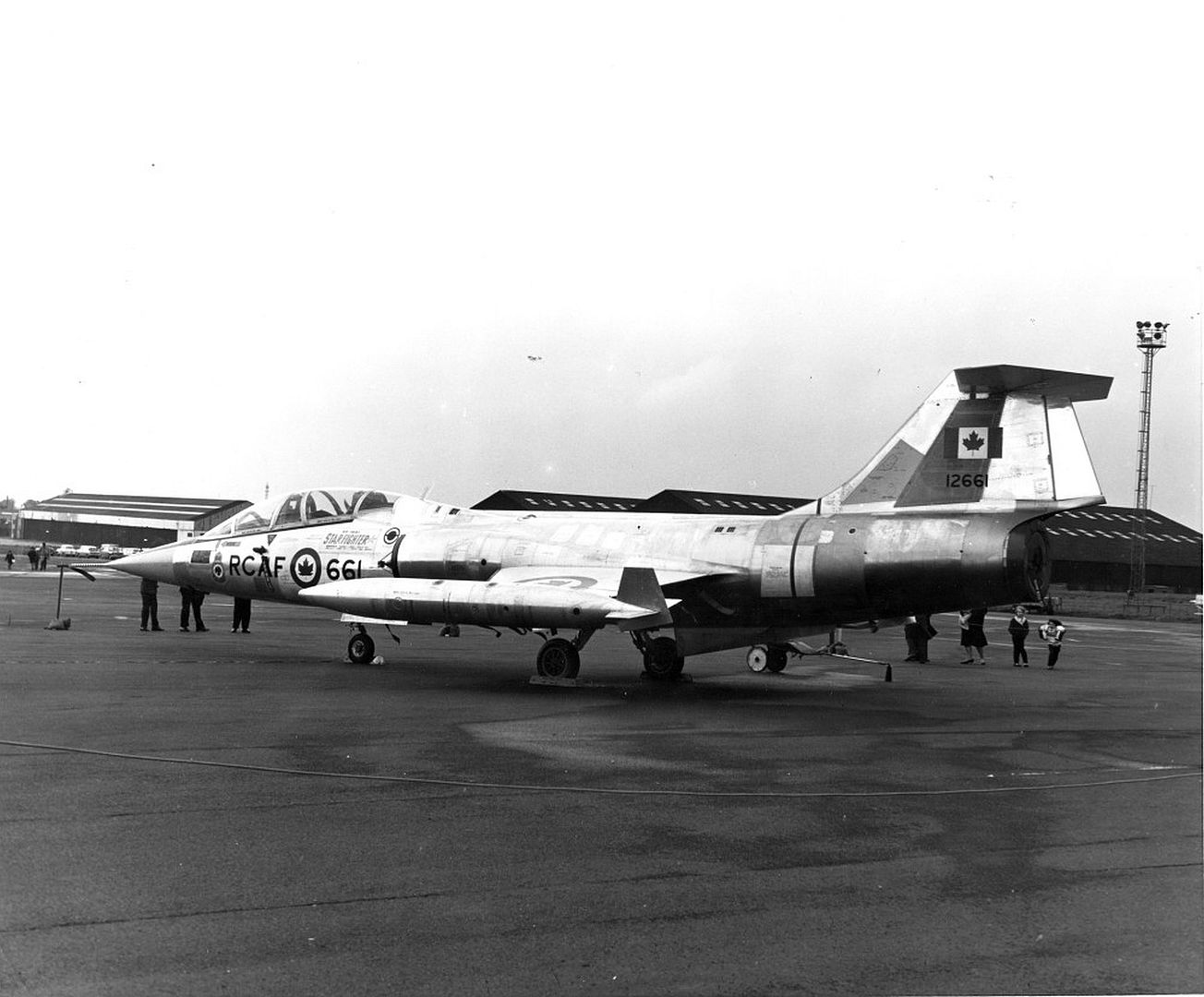
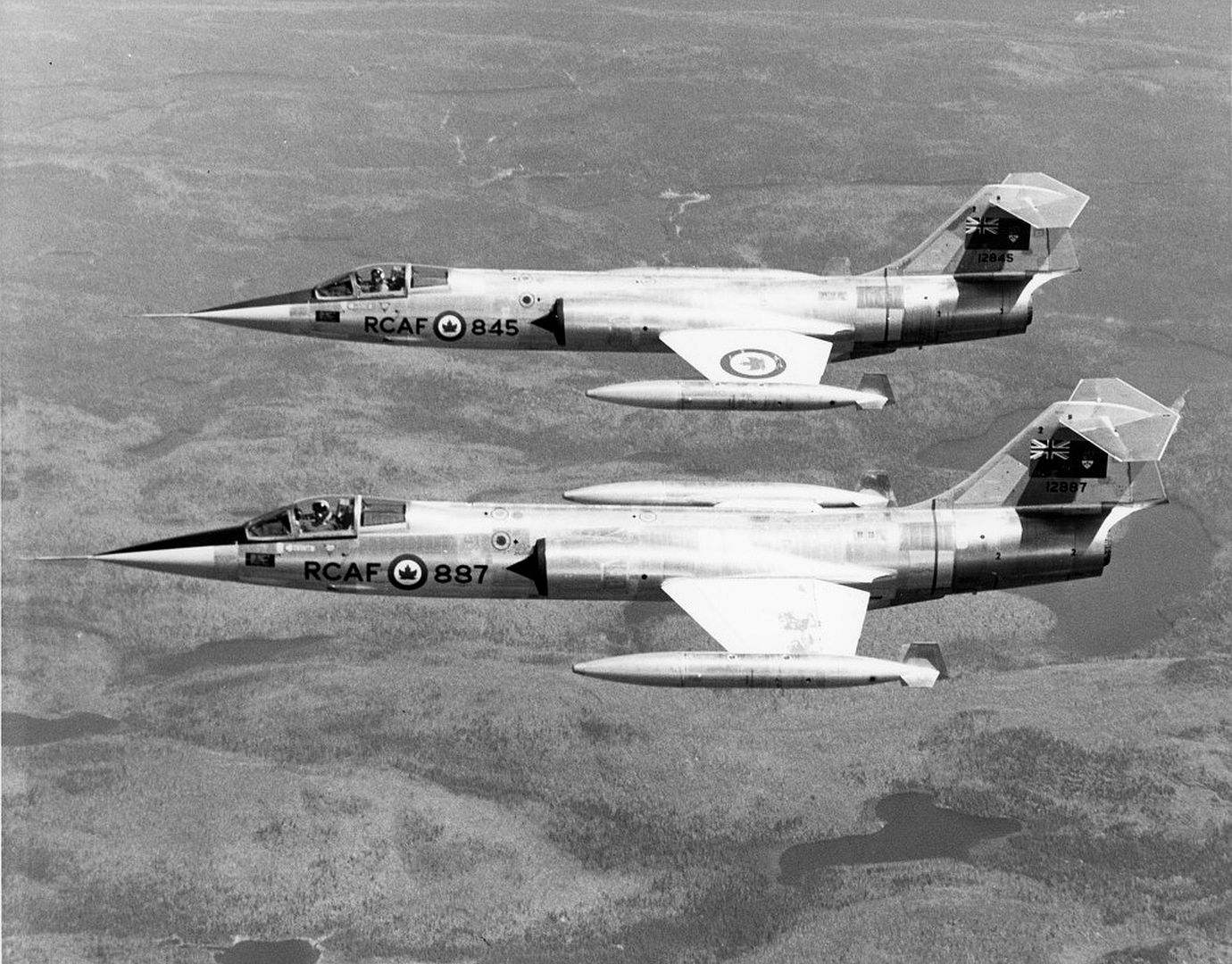
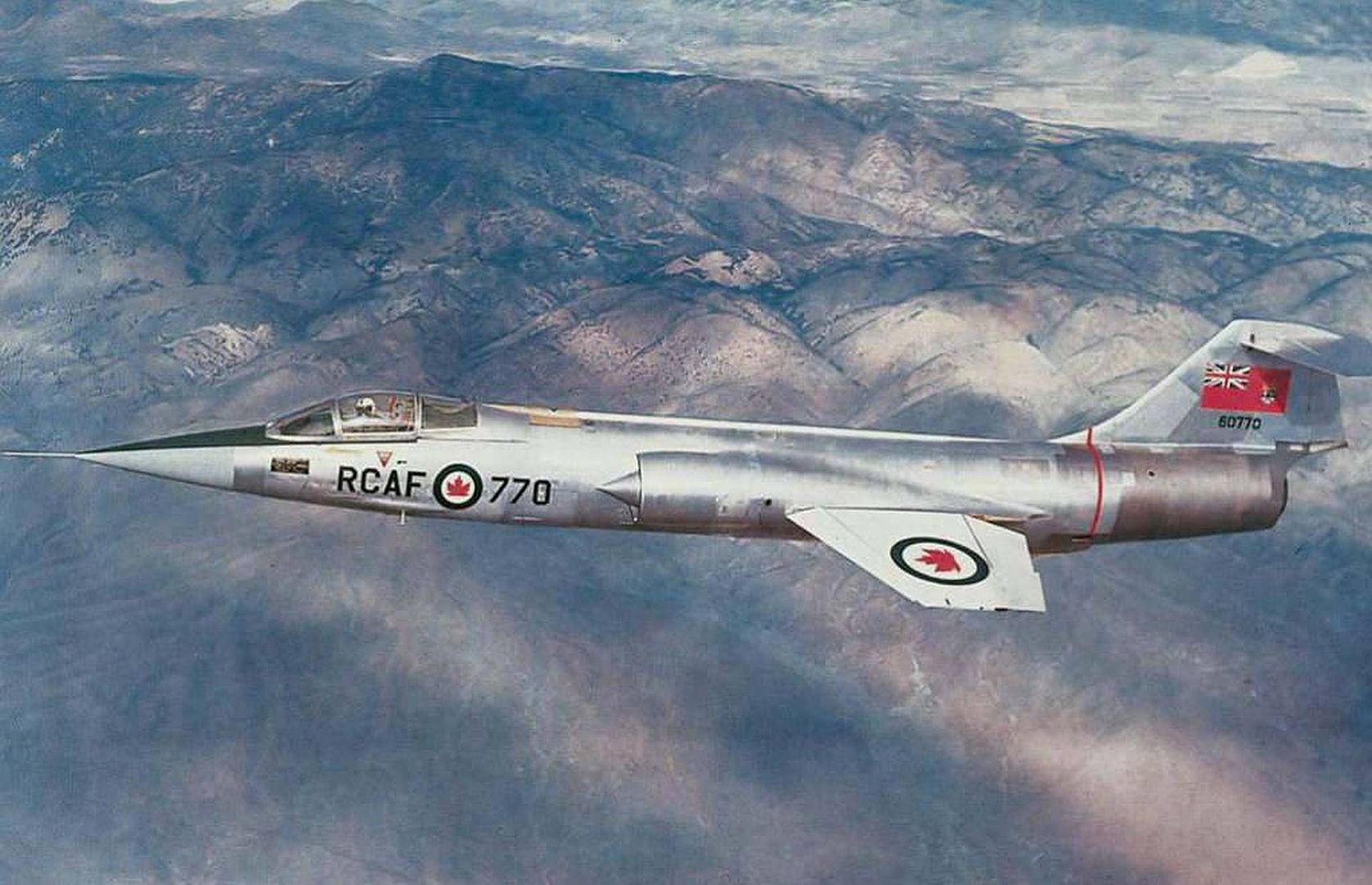



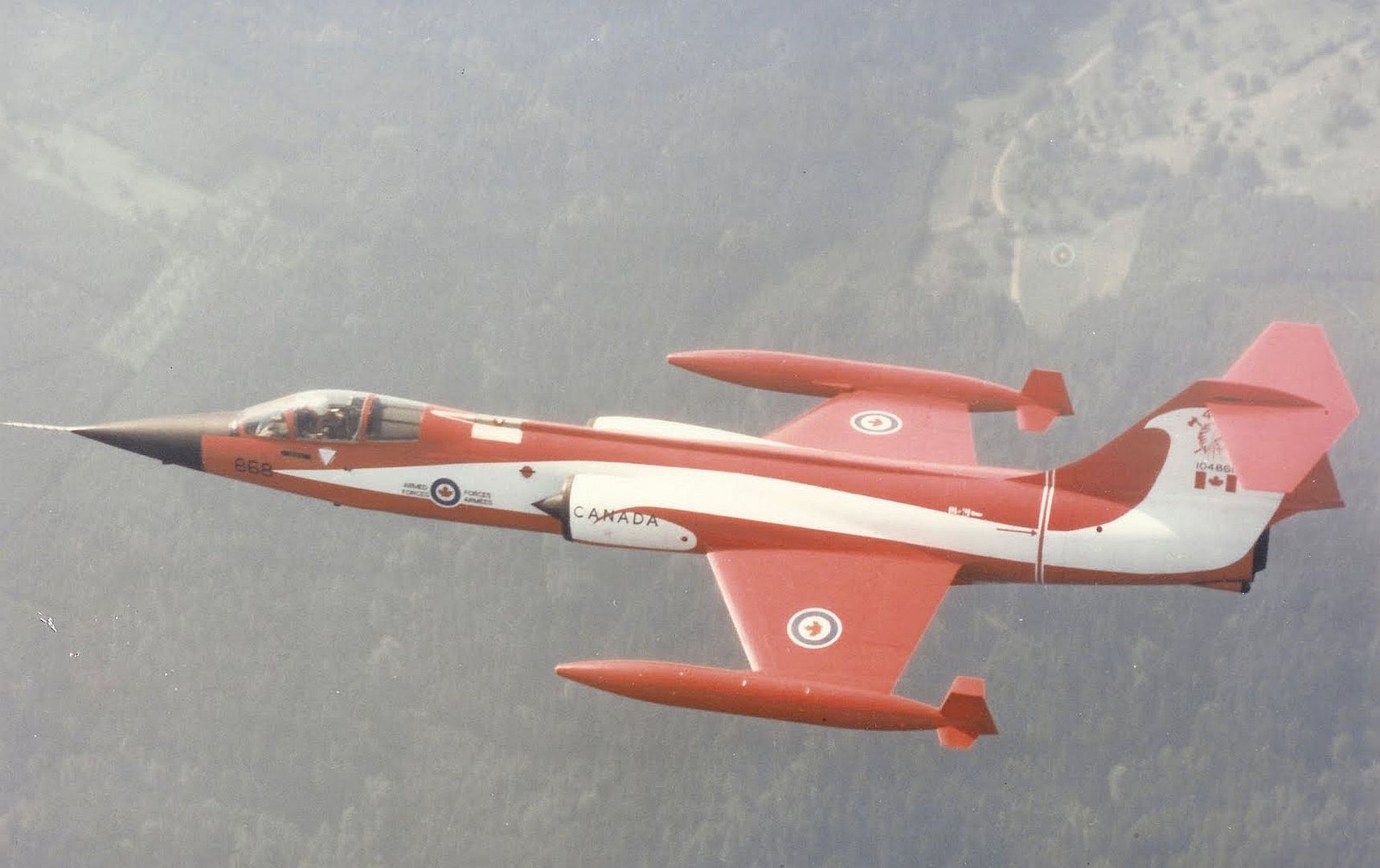
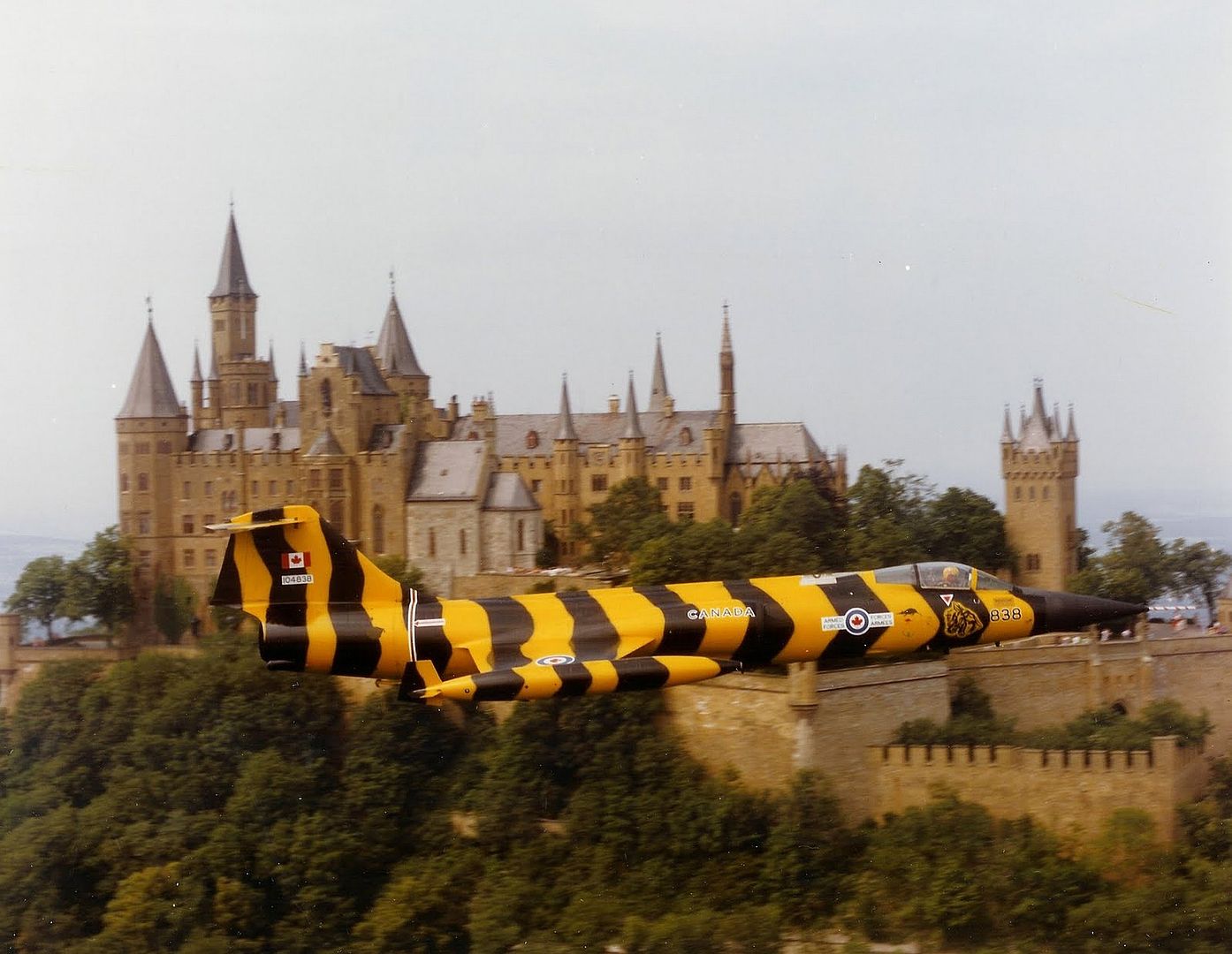
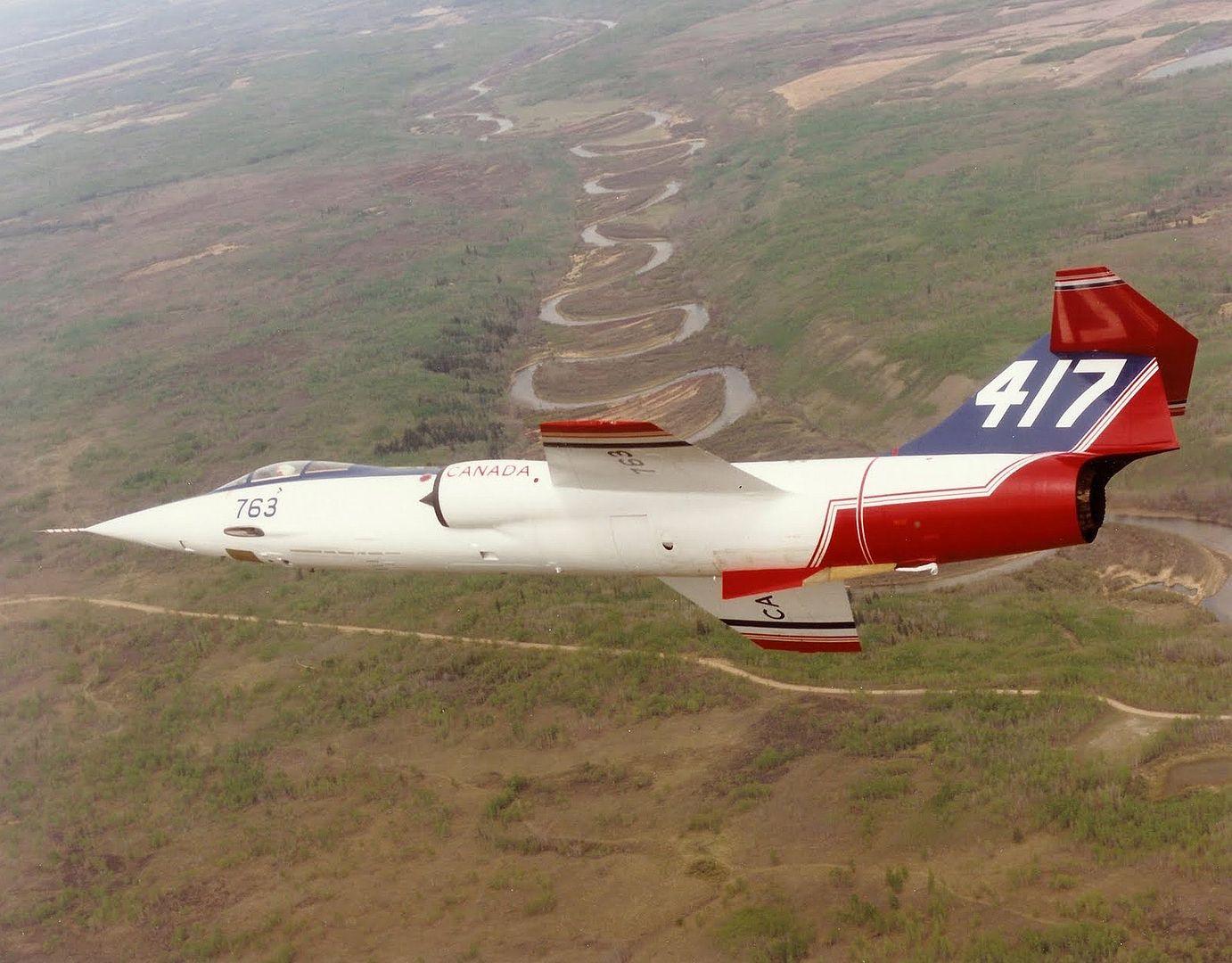
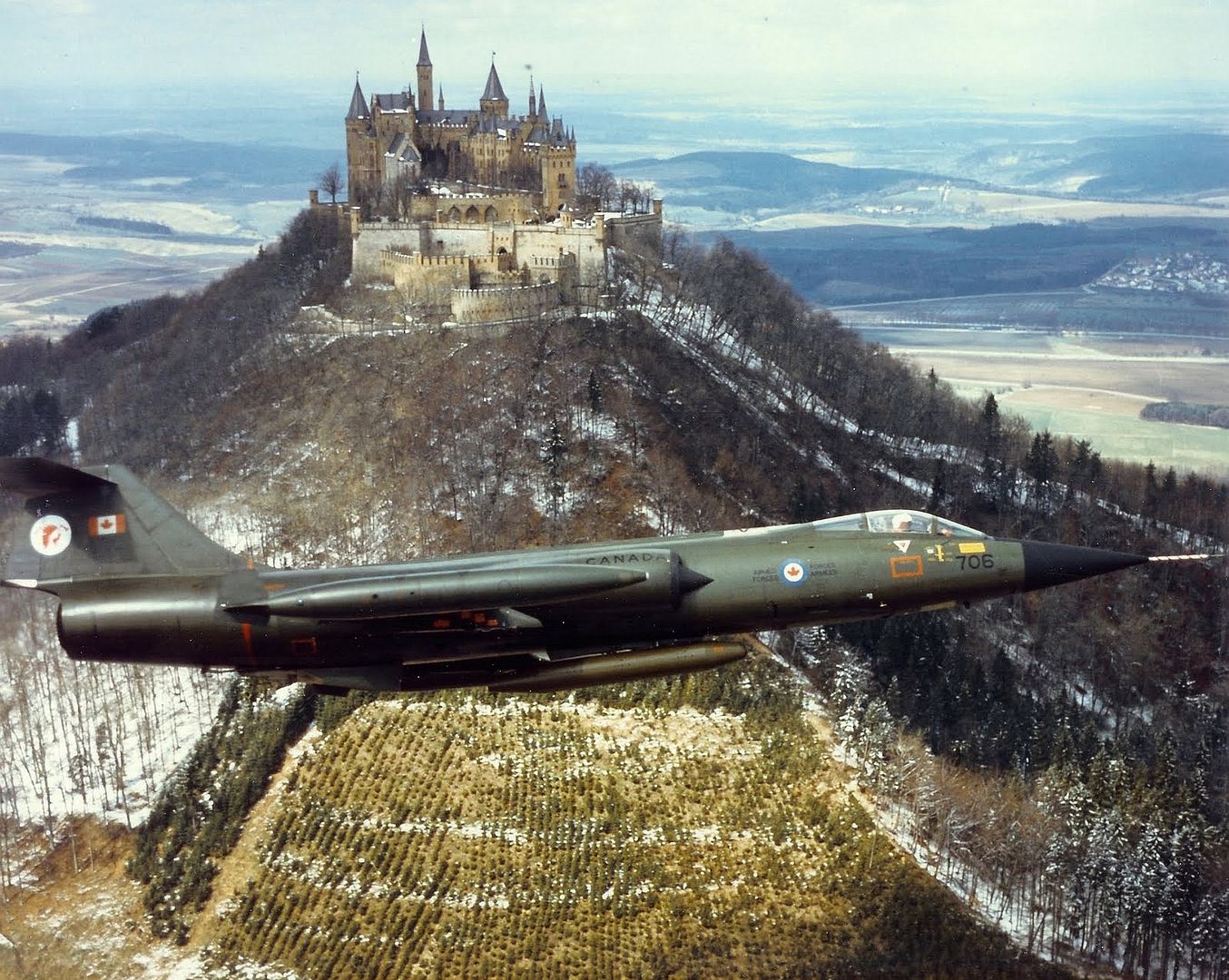
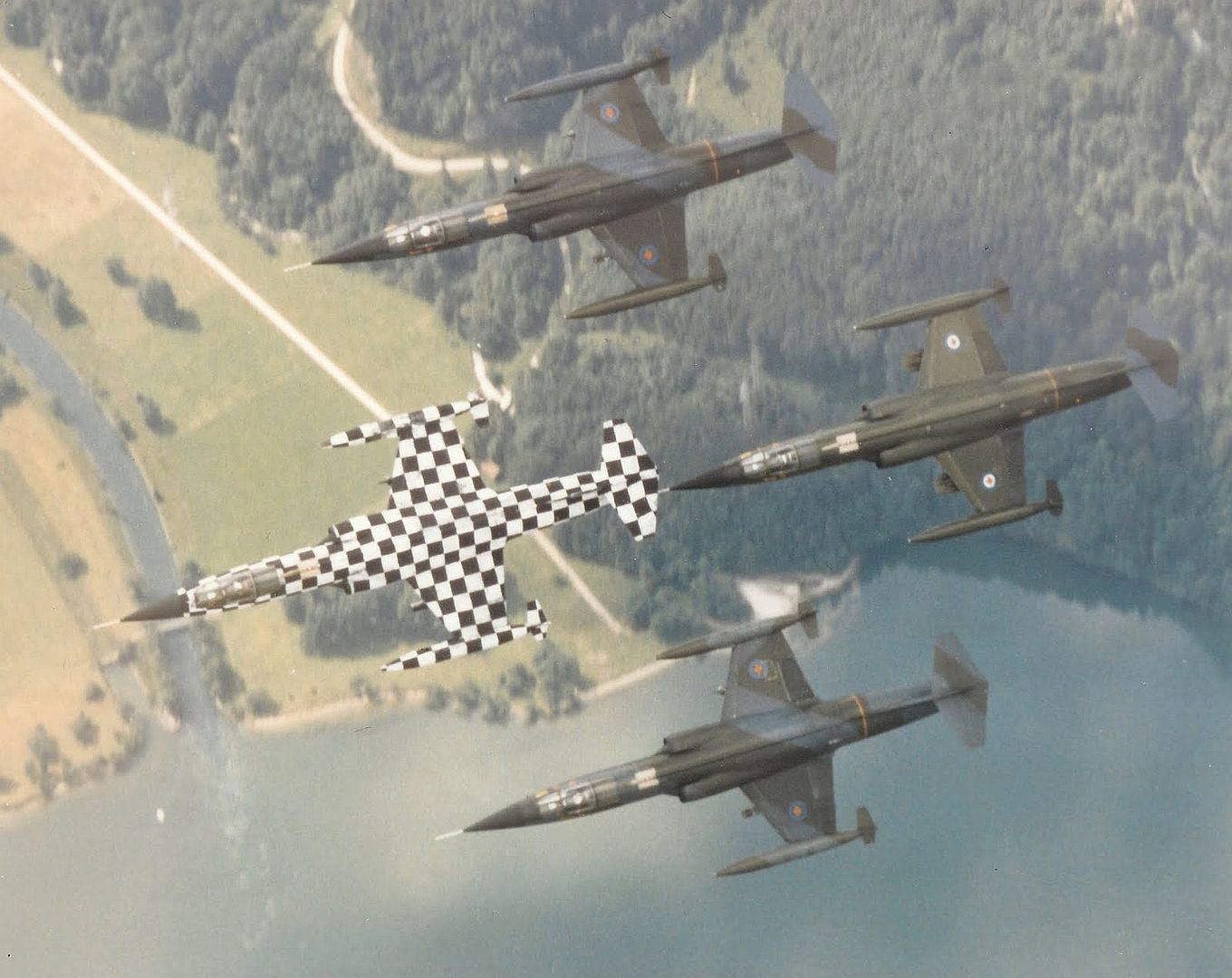
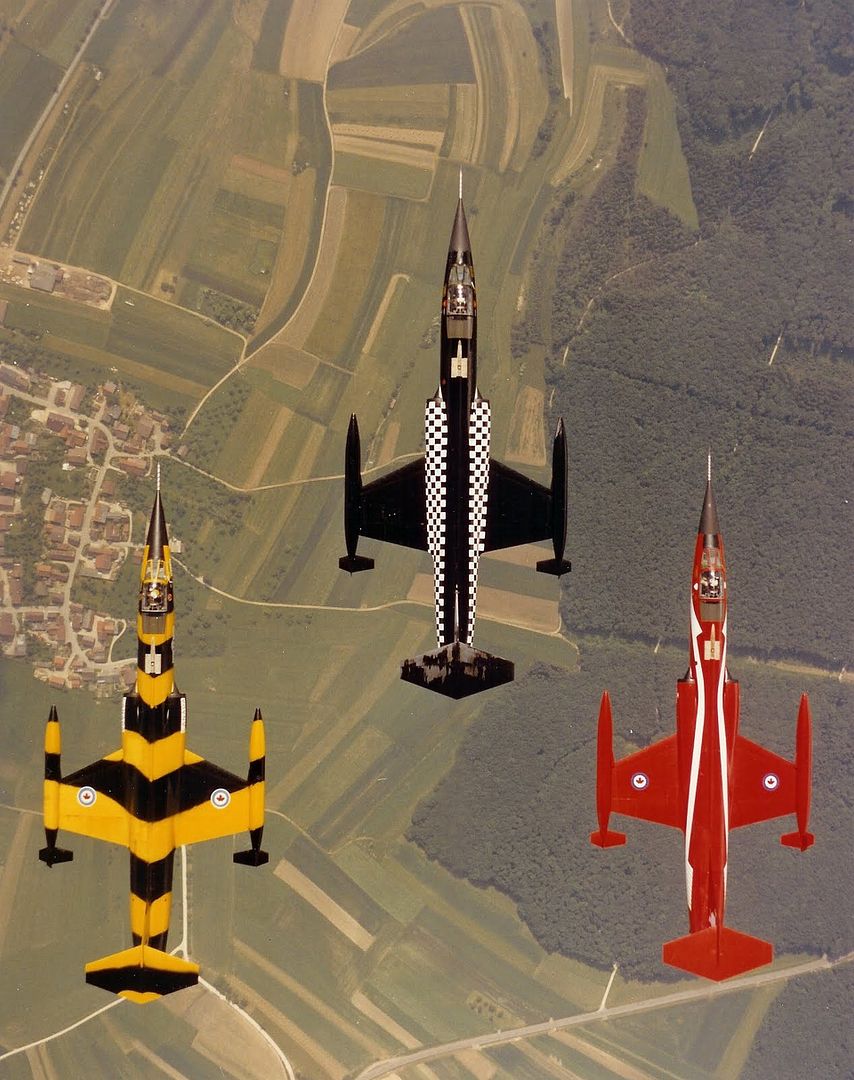

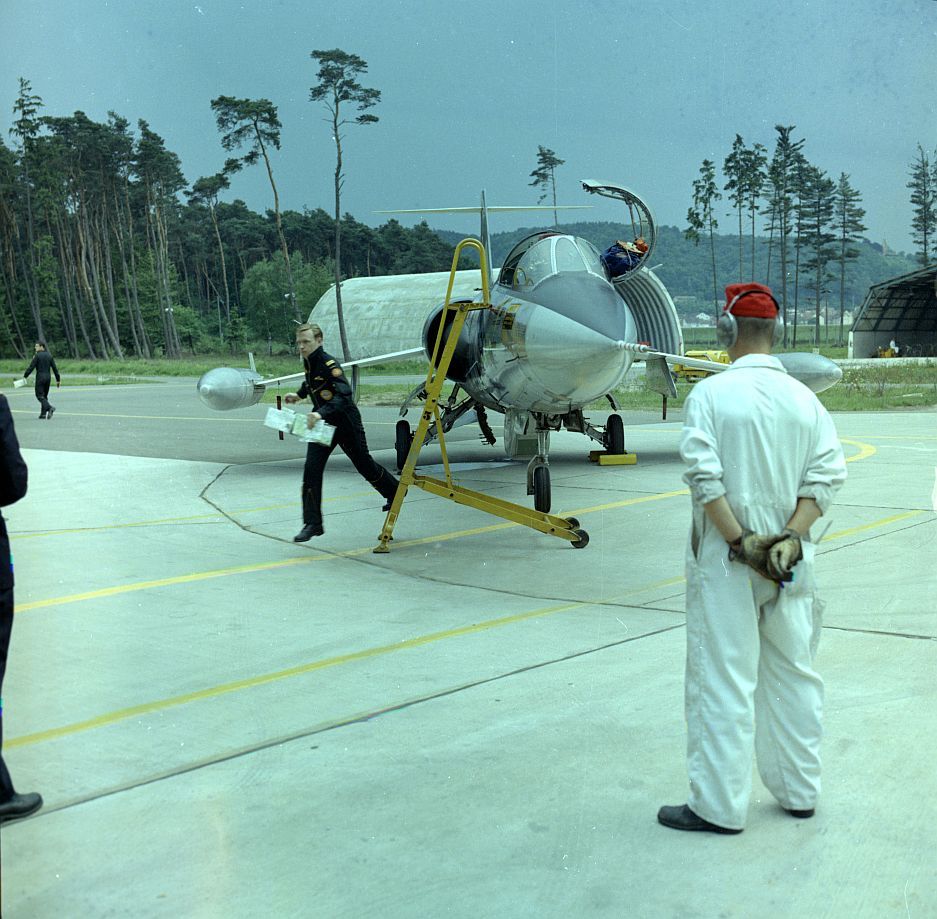

-
 Main AdminJapanese Starfighters
Main AdminJapanese Starfighters
The Japanese Air Self-Defense Force (JASDF) obtained a total of 210 "F-104J" single-seaters and 20 "F-104DJ" two-seaters. Three of the F-104Js were provided by Lockheed as pattern machines for a production group led by Mitsubishi Heavy Industries (MHI); 29 were assembled by MHI from knockdown kits; and the rest of the single-seaters were built by MHI with mostly local content. The first F-104J made its initial flight on 30 June 1961, with MHI assembly and production beginning in the spring of 1962 and running into 1967. The F-104DJs were all provided as knockdown kits and were assembled by MHI in parallel with F-104J production.
The F-104J / F-104DJ were based on the F-104G / TF-104G airframe but, in keeping with the strict Japanese "self-defense" mentality, were optimized for the interceptor role, with a different set of avionics, including some Japanese kit. They used the F15J-31 variant of the NASARR radar, which featured only air-to-air modes. Primary armament was the Sidewinder AAM. They were powered by the J79-IHI-11A engine, which was a J79-GE-11A built under license by Ishikawajima-Harima Heavy Industries (IHI). Photos show some F-104Js with the centerline catamaran mount for twin Sidewinders.
Japanese Starfighters were originally flown in natural-metal finish, with white-painted wings highlighting the red "Rising Sun" national insignia to help recognition. Later they were painted overall light gray to prevent corrosion, with some aircraft given a black nose. Apparently JASDF aircrew really liked the F-104J; it was a real pilot's aircraft, a fitting mount for a sky samurai.
The JASDF finally retired their F-104s in the mid-1980s, to be replaced by the McDonnell F-15J Eagle. Some were retained in special roles for a time, and others were passed on to Taiwan. The JASDF lost about 15% of their Starfighters in accidents, not too bad an attrition rate for two decades of operations. A few F-104Js were converted to "QF-104J" target drones in the 1990s.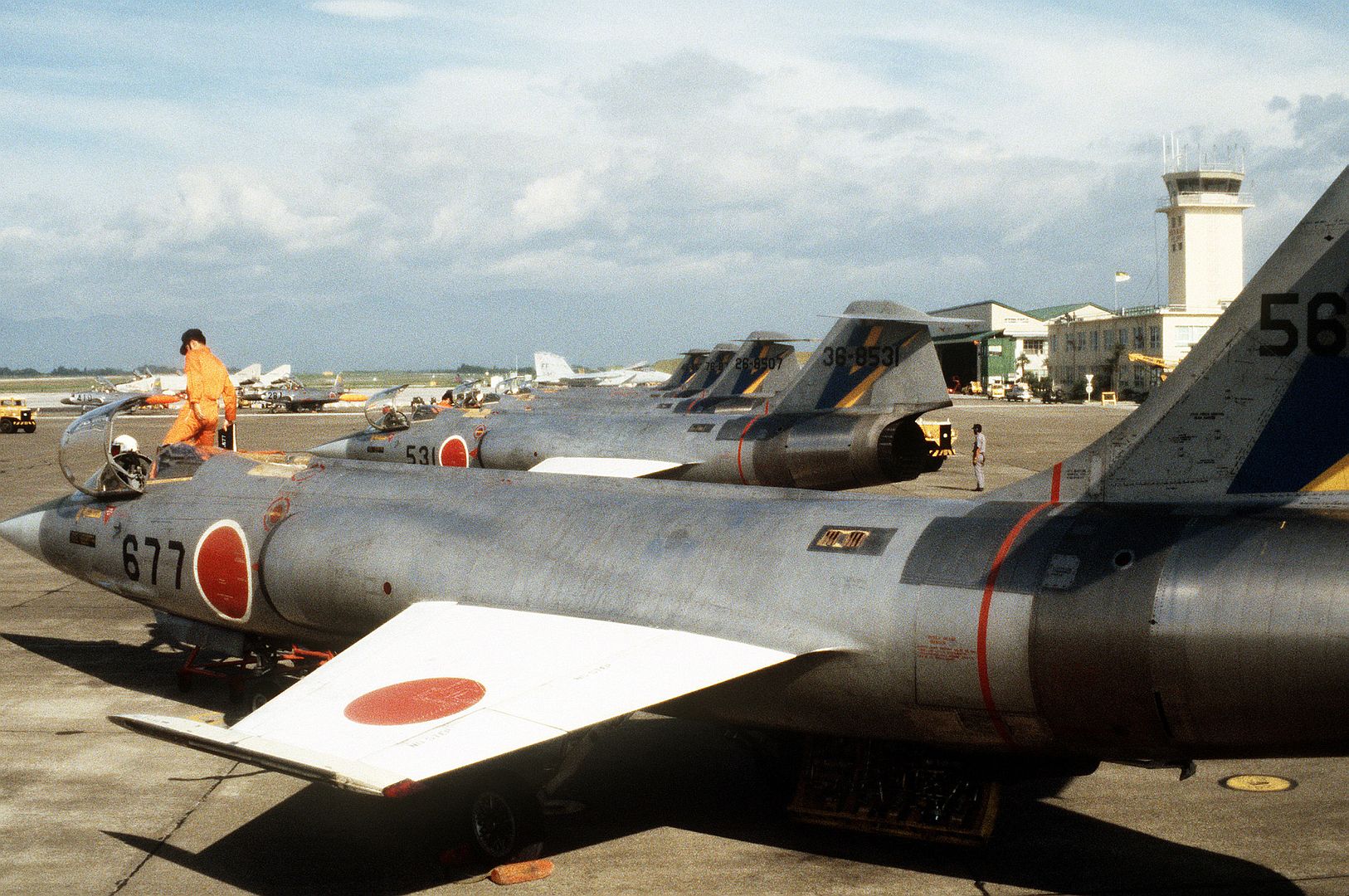
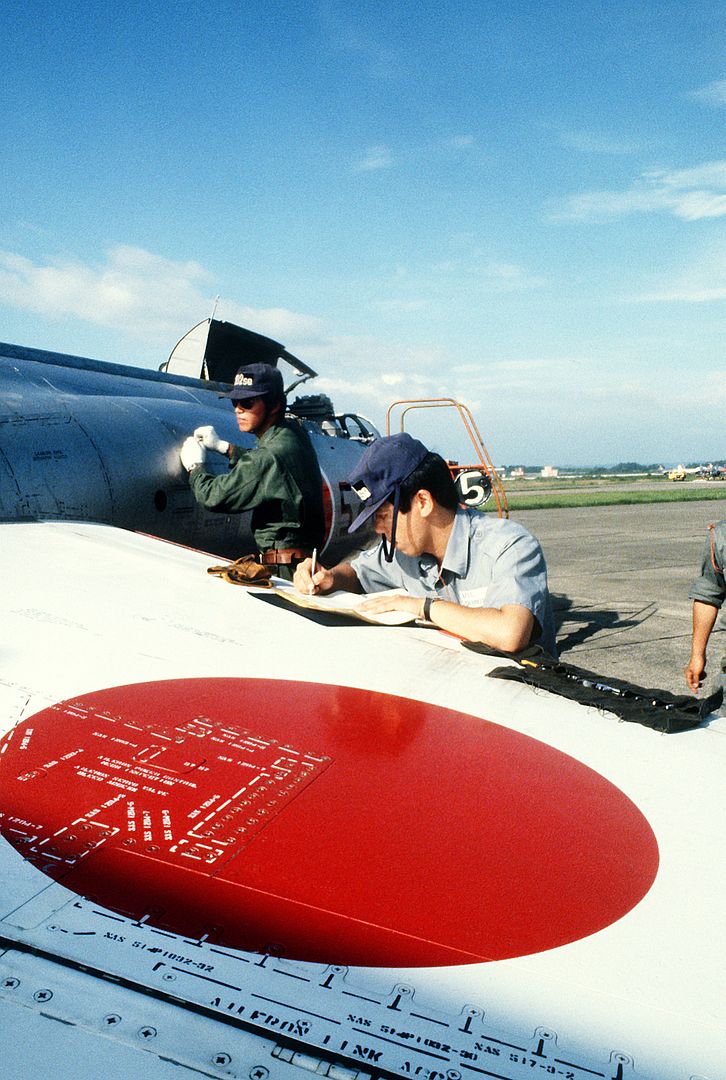
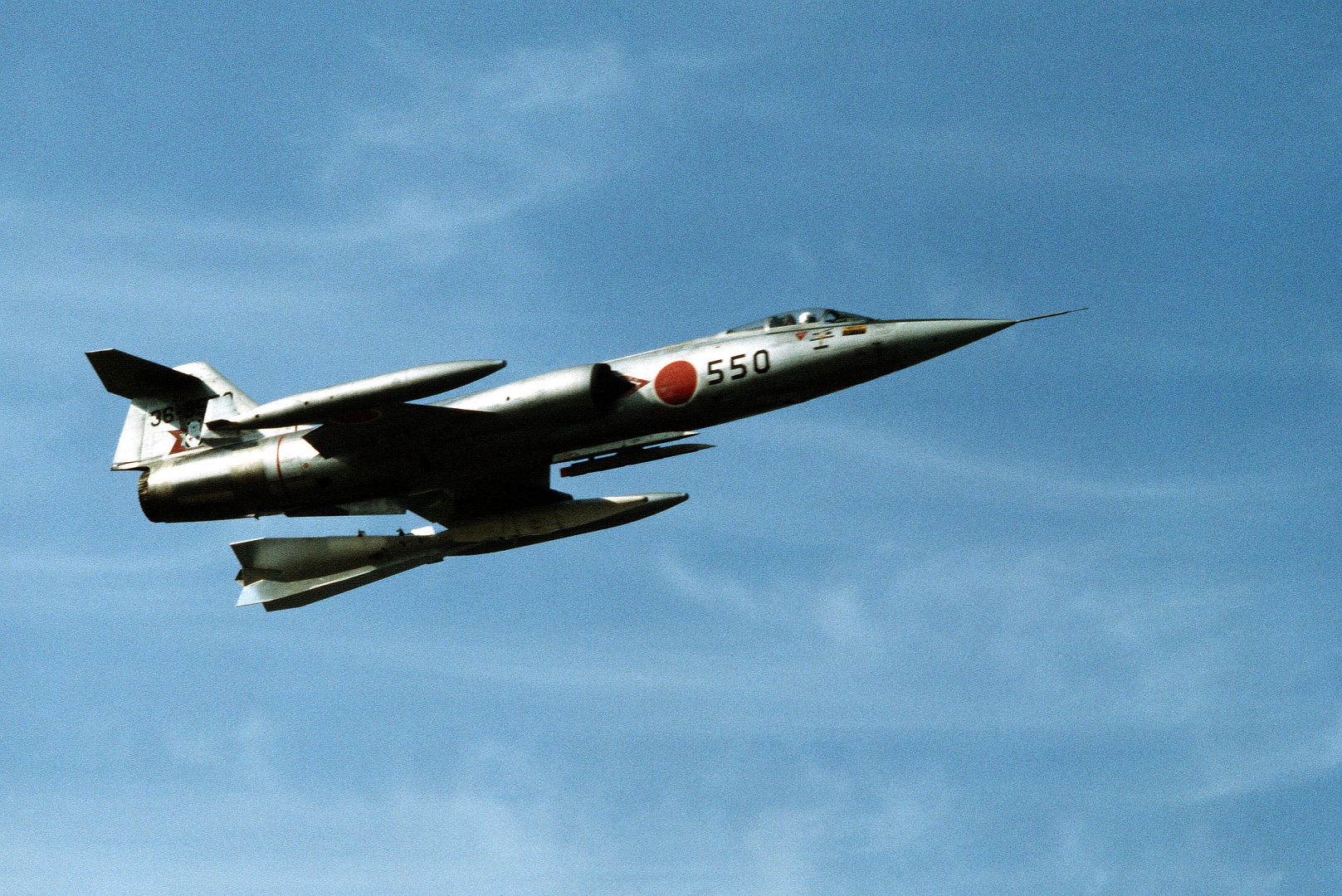
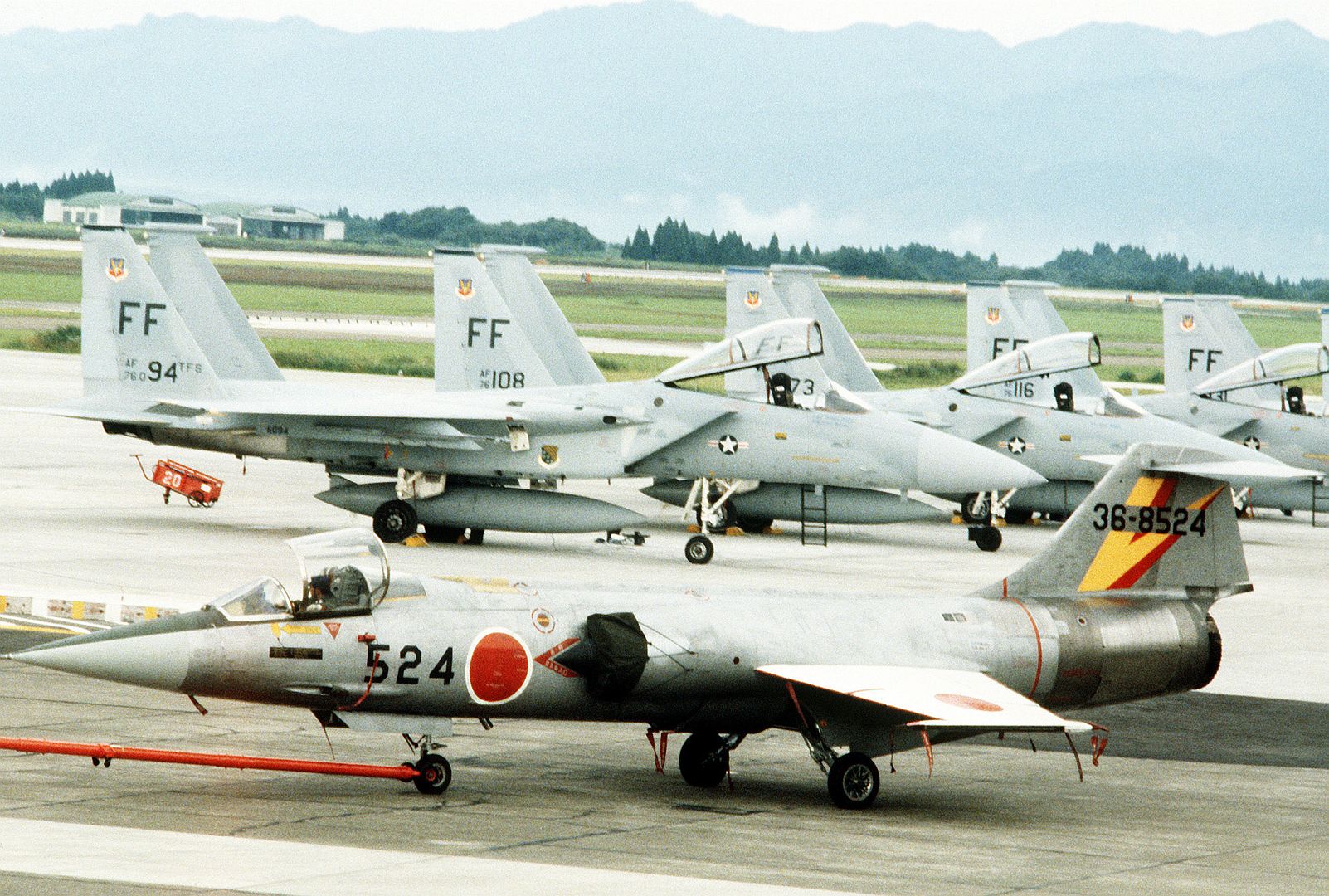
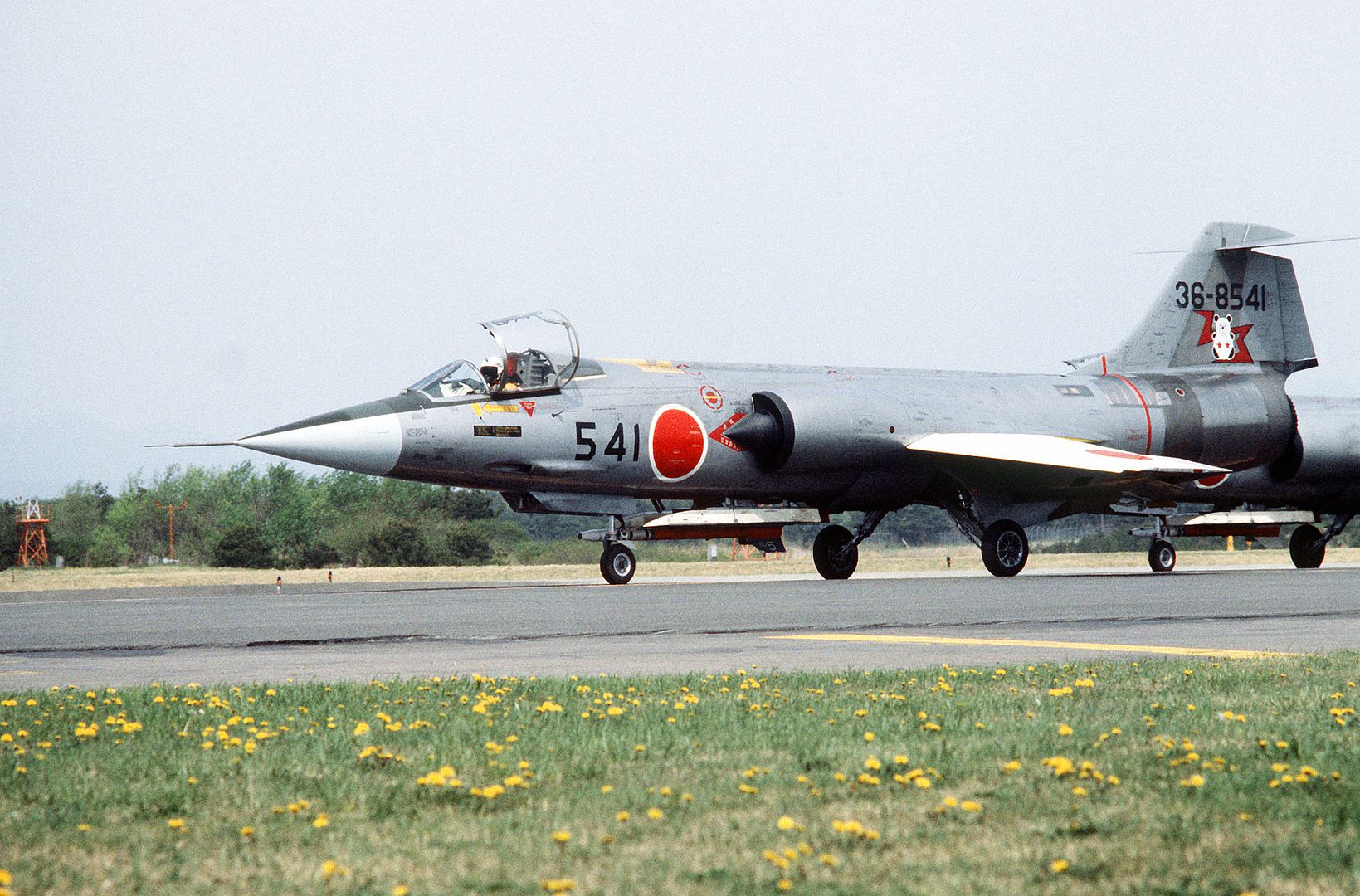
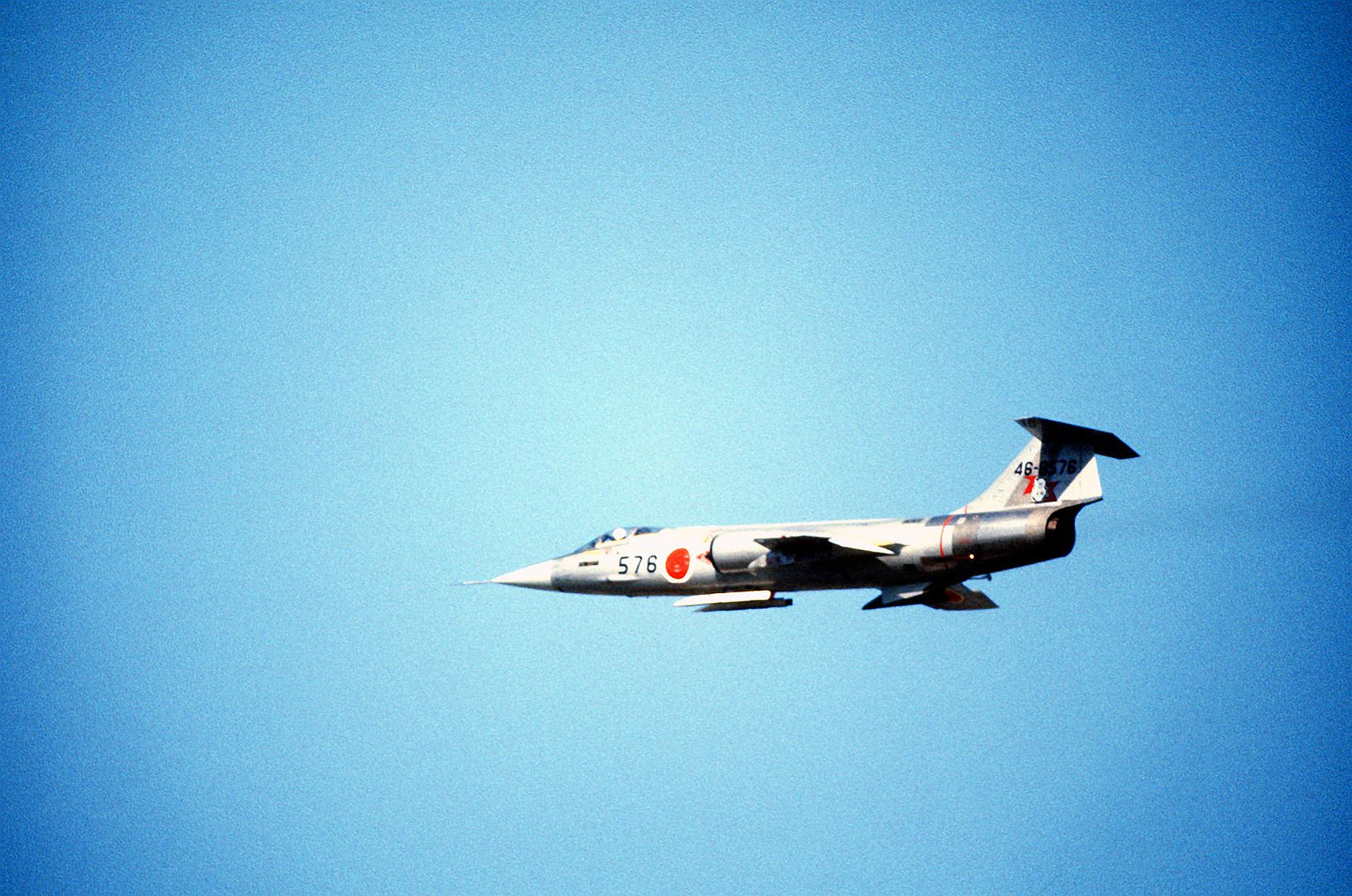
-
 Main AdminItalian Starfighters
Main AdminItalian Starfighters
Fiat manufactured a total of 125 F-104Gs for the Italian Air Force (Aeronautica Militaire Italiana / AMI). One of these machines was a pattern aircraft supplied by Lockheed. The first Fiat-built F-104G performed its initial flight on 9 June 1962, with the first operational Starfighter squadrons coming online in 1965. The Starfighter replaced the F-86 and F-84 / RF-84 in AMI service. The F-104 acquired a number of nicknames in Italian service, the most prominent being "Spillone (Hatpin)".
Of the 125 F-104Gs for the AMI, 51 were configured as interceptors, 54 were configured for the strike role, and 20 were configured as RF-104Gs, with the built-in trimetrogon camera arrangement. A number of F-104Gs would later be modified to carry the Dutch Orpheus reconnaissance pod.
The AMI also obtained 12 TF-104Gs from Lockheed and 12 from Aeritalia, giving a total of 24 trainers. Six more TF-104Gs were passed on from Luftwaffe stocks in the mid-1980s, with at least two refurbished and some used as spares hulks. The Italians also considered obtaining a version of the Macchi MB-326 trainer with NASARR radar and a Starfighter nose, but this project never got out of the paper stage.
Italian F-104Gs were delivered with the Martin Baker 1Q7A ejection seat. The Italians were generally consistent in their color schemes, providing their Starfighters with a dark gray / dark green disruptive pattern on top and light gray on the bottom. They seemed particularly fond of flashy temporary paint jobs for special occasions, for example with a stretched-out cat chasing mice on one side of the fuselage.
* The Italians liked the Starfighter enough to order an enhanced variant, the "CL-901" or "F-104S", the "S" indicating carriage of the Sparrow semi-active radar homing medium-range AAM. The AMI considered other aircraft for the service requirement, including the Dassault Mirage III, the F-4 Phantom, and the F-5, but despite the Starfighter's accident record the F-104 won out, the award being announced in 1965. The Phantom was more flexible, but the F-104S was faster, cheaper and, very importantly, provided more work for the Italian aviation industry.
Two subvariants were built, the "F-104S/CI" for the interceptor role and the "F-104S/CB" for the fighter-bomber role. They featured:
An uprated J79-GE-19 turbojet with 79.6 kN (8,120 kgp / 17,900 lbf) thrust and 13% better fuel economy in cruise. The intakes were moved back very slightly and widened to provide the needed additional airflow.
Modernized avionics, including a Litton LN-3-13 INS and an improved NASARR radar, with the radar built by FIAR of Milan. Sources are confusing on the updated radar, some suggesting that both variants had the same radar, most saying they were different -- but giving inconsistent designations for the two. Enough to the say the radar for the interceptor had continuous-wave target illumination to support the Sparrow AAM, while the radar for the fighter-bomber had air-to-ground modes. There may have been some overlap between the two; and maybe they were really one and the same. The fighter-bomber also included a radar altimeter.
Nine stores stations, including the wingtip attachment points, two pylons under each wing, the centerline pylon, and two pylons under the forward fuselage.
A small ventral fin flanking either side of the main ventral fin to improve yaw stability.
Primary armament of the interceptor subvariant was two AIM-7 Sparrow III AAMs, plus two or more Sidewinders. The cannon was deleted to make space for Sparrow control systems. When late-model Sparrows and Sidewinders were introduced that were far more reliable and effective than those used in the 1960s, the F-104S was a formidable interceptor. The attack subvariant retained the Vulcan cannon, and could carry a total external warload of 3,400 kilograms (7,500 pounds).
Lockheed modified two Italian F-104Gs into prototypes for the F-104S. The first prototype flew on 22 December 1966, followed by the second in March 1967. Fiat built 206 F-104S Super Starfighters for the AMI, the total being split roughly evenly between interceptors and fighter-bombers, as well as 81 for the Turkish Air Force. Initial deliveries to the AMI were in 1969, and the last F-104S was delivered in 1979. Another 40 F-104S Starfighters were built for the Turks, giving a total production of 246 machines.
Final deliveries of the F-104S led to the AMI's withdrawal of the F-104G from the interceptor and fighter-bomber roles in the early 1980s, though as mentioned some F-104Gs were modified to carry the Orpheus pod for the reconnaissance mission. These reconnaissance machines actually served in the Gulf War in 1991, flying out of Turkish bases to keep an eye on northern Iraq.
In the early 1980s an upgrade program, the "Aggiornamento Systema d'Arma / ASA / Updated Weapons System", was implemented for 147 AMI F-104S Starfighters, though the initial plan had been for 153 aircraft. The first upgraded aircraft was flown in 1984, with service deliveries from 1986 into 1993.
The F-104S ASA featured improved FIAR radar with look-down shoot-down capability; a capable self-defense suite with an RWR and chaff-flare dispensers; and carriage of the Selenia Aspide 1A AAM, a derivative of the AIM-7E Sparrow. The Vulcan cannon was refitted to upgraded interceptors, since the avionics had shrunk considerably in the meantime. In principle the F-104S ASA could carry the Kormoran anti-ship missile, though in practice it never did.
The F-104S ASA was selected basically as an interim solution until the multi-national Eurofighter was available, but as is often the case in multi-national programs, the Eurofighter development effort dragged out. In the late 1990s, faced with the obsolescence of the Starfighter force, the AMI decided to lease 24 ex-Royal Air Force Tornado interceptors, and upgrade a subset of the Starfighter force again.
The modernization program was relatively minimal, focusing mostly on simply keeping the machines flying safely while doing little to improve combat effectiveness. The electrical system was replaced and a new avionics suite was installed -- featuring a new INS, a (separate) Global Positioning System (GPS) receiver, and other new kit. 49 F-104S ASA machines were upgraded, being given the designation of "F-104S ASA-M", and 15 TF-104Gs were upgraded, being given the designation of "TF-104G-M". The gunsight and countermeasures suite of the single-seaters were pulled, while all combat gear was yanked from the two-seaters.
Initial flight of the F-104S ASA-M was in 1995, with initial deliveries in 1997. These machines served in an operational role in 1999 during Operation ALLIED FORCE, the NATO air campaign against Serbia. The Starfighters were used for combat air patrols, being occasionally directed by airborne warning and control aircraft to check out bogeys.
The last AMI Starfighter was retired in the summer of 2004. At least 138 were lost in crashes, or about 37.5% of the total.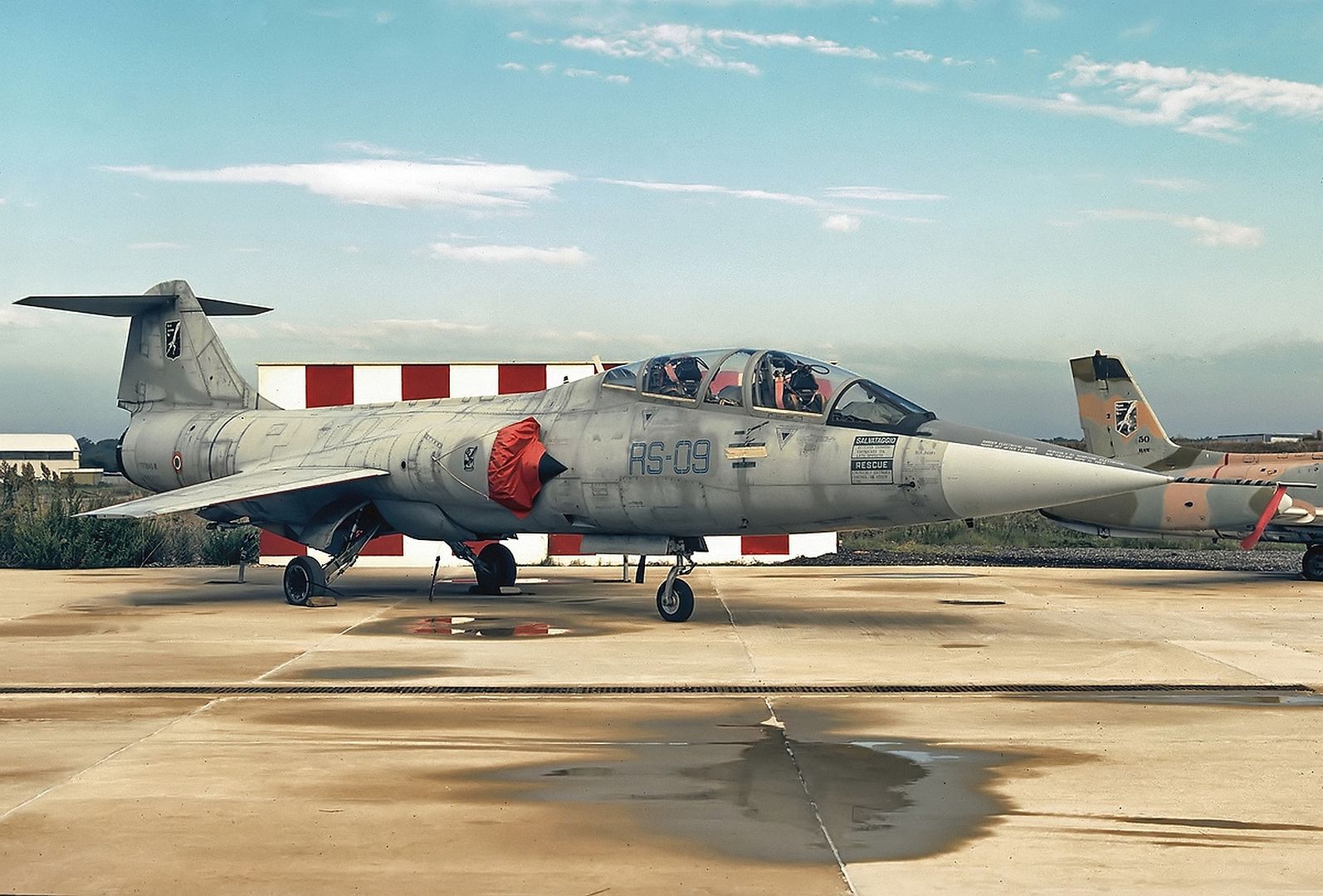
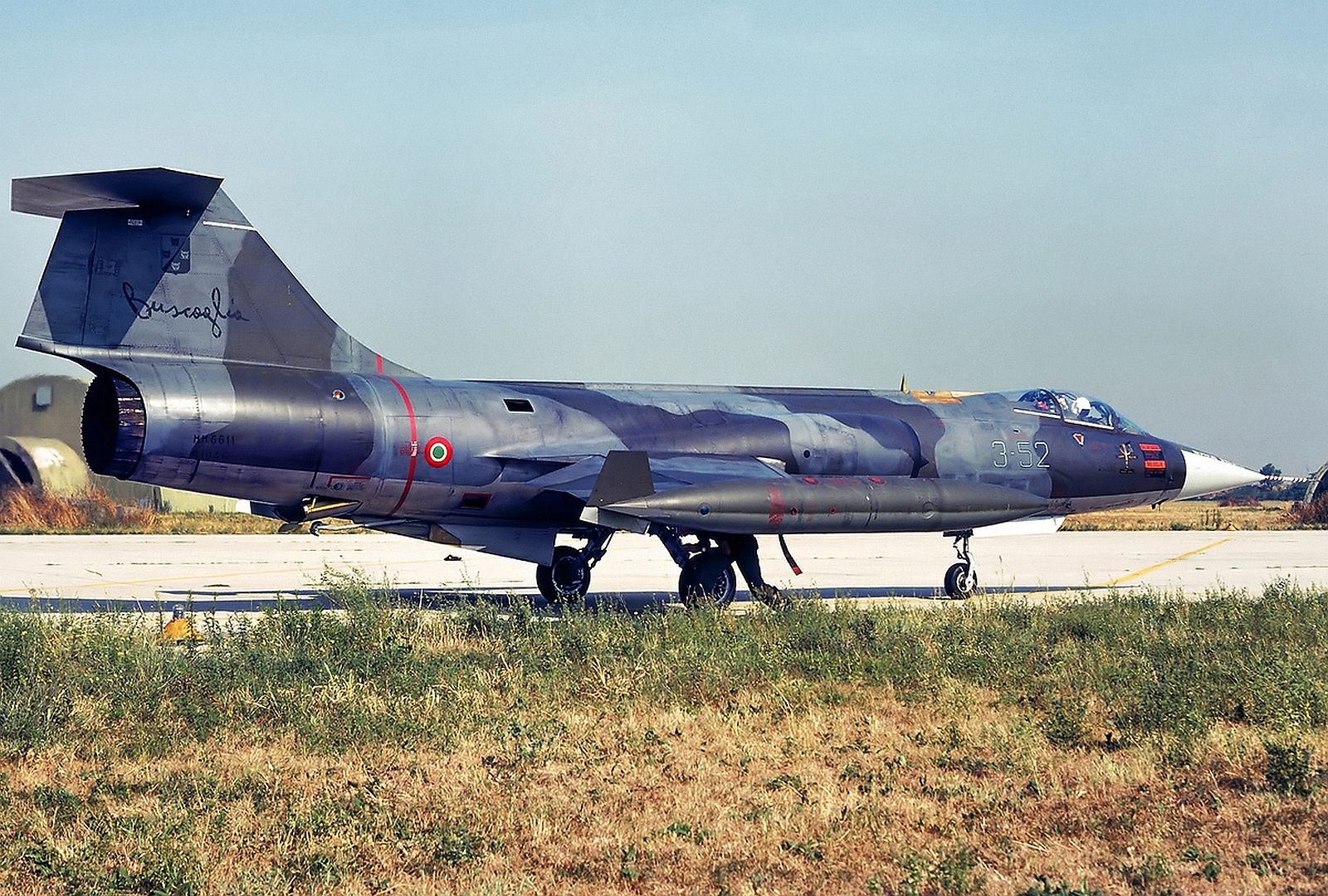
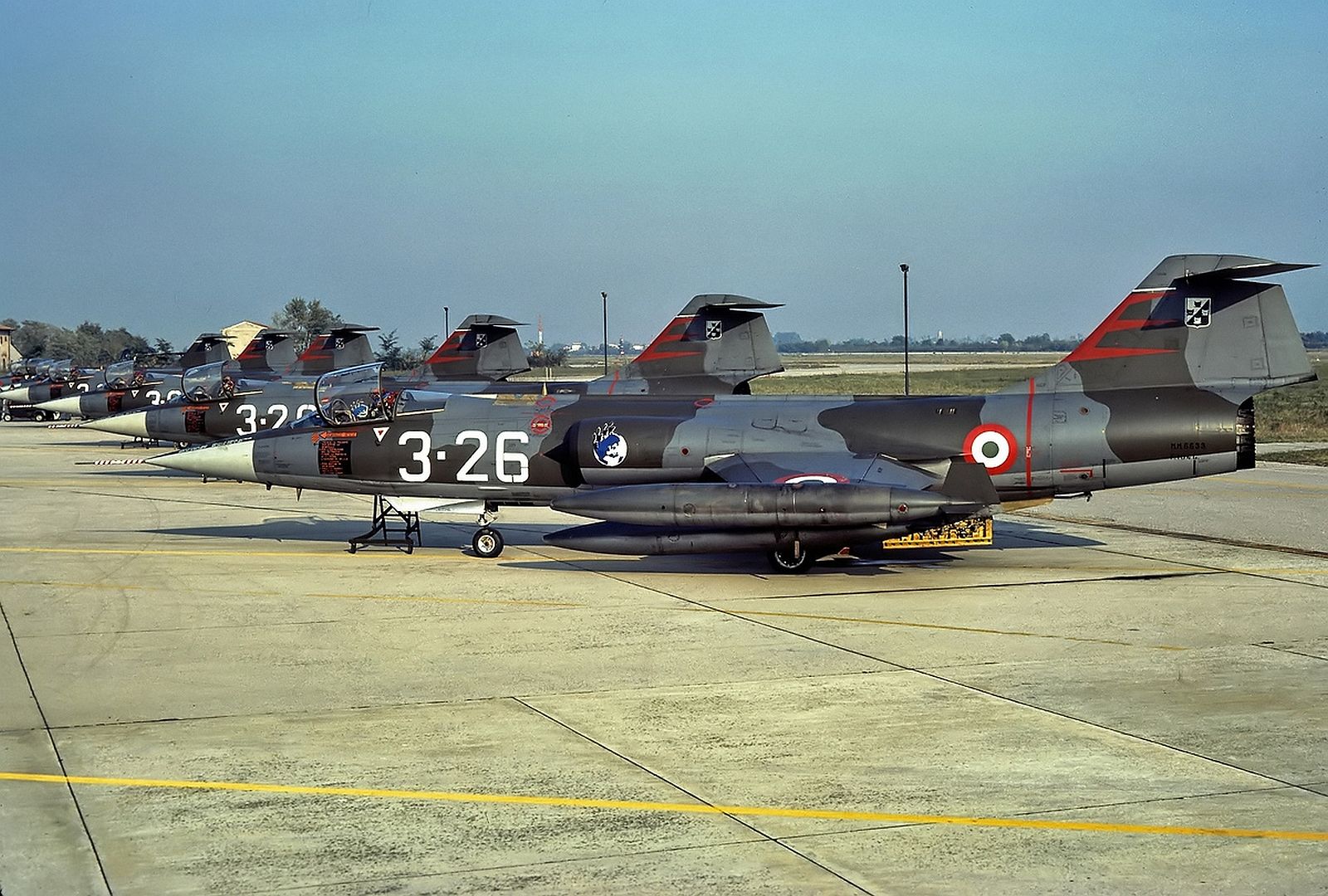



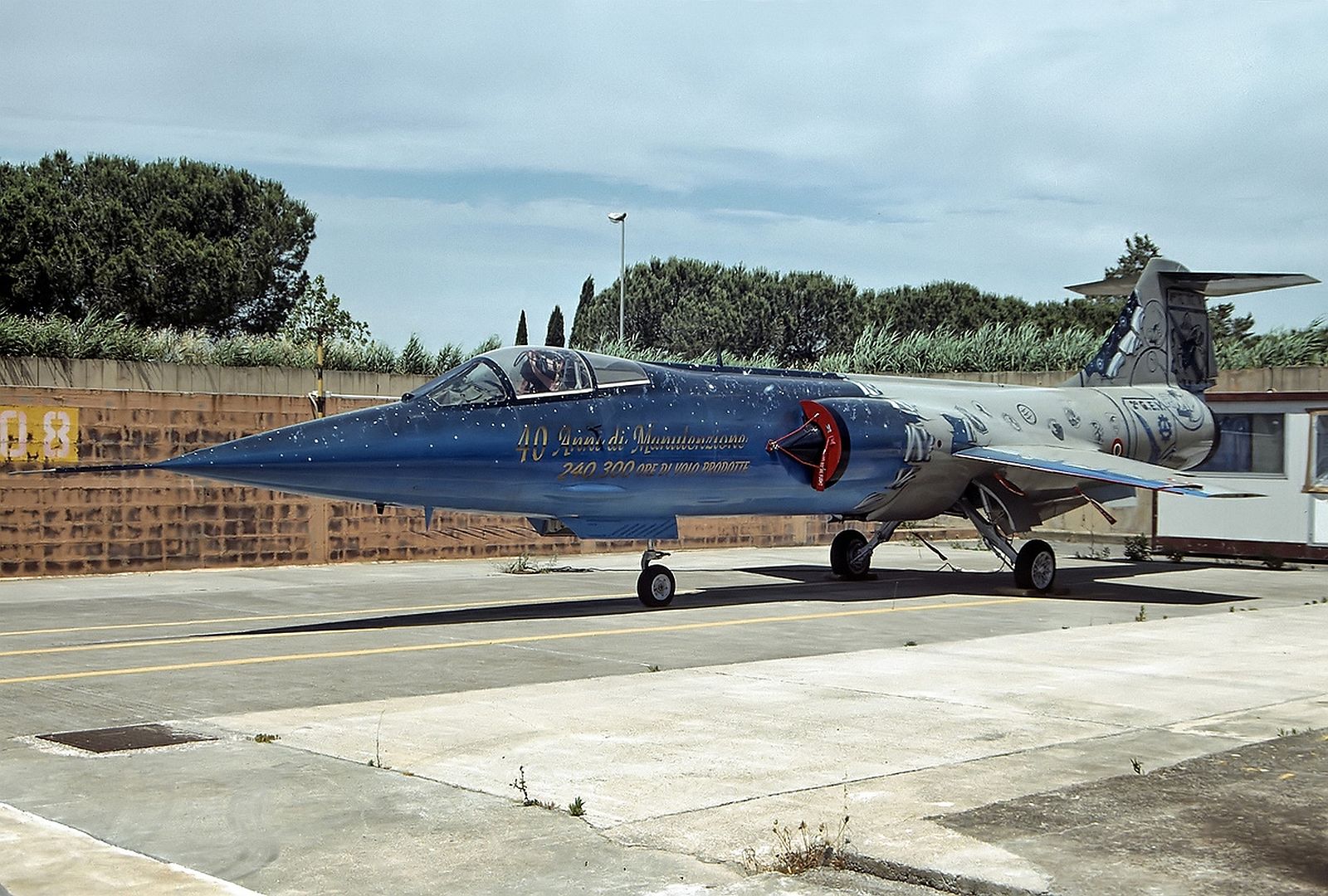
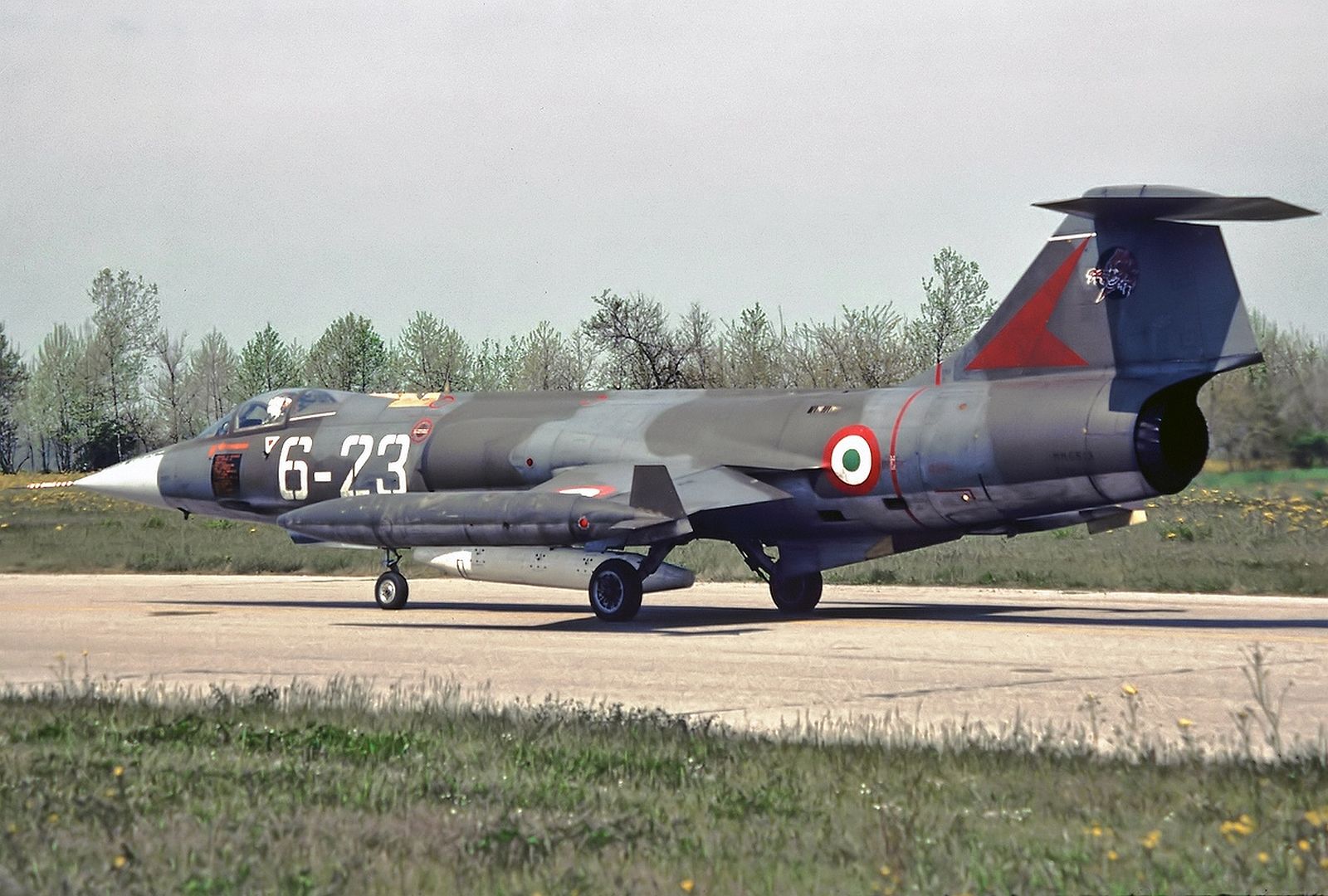
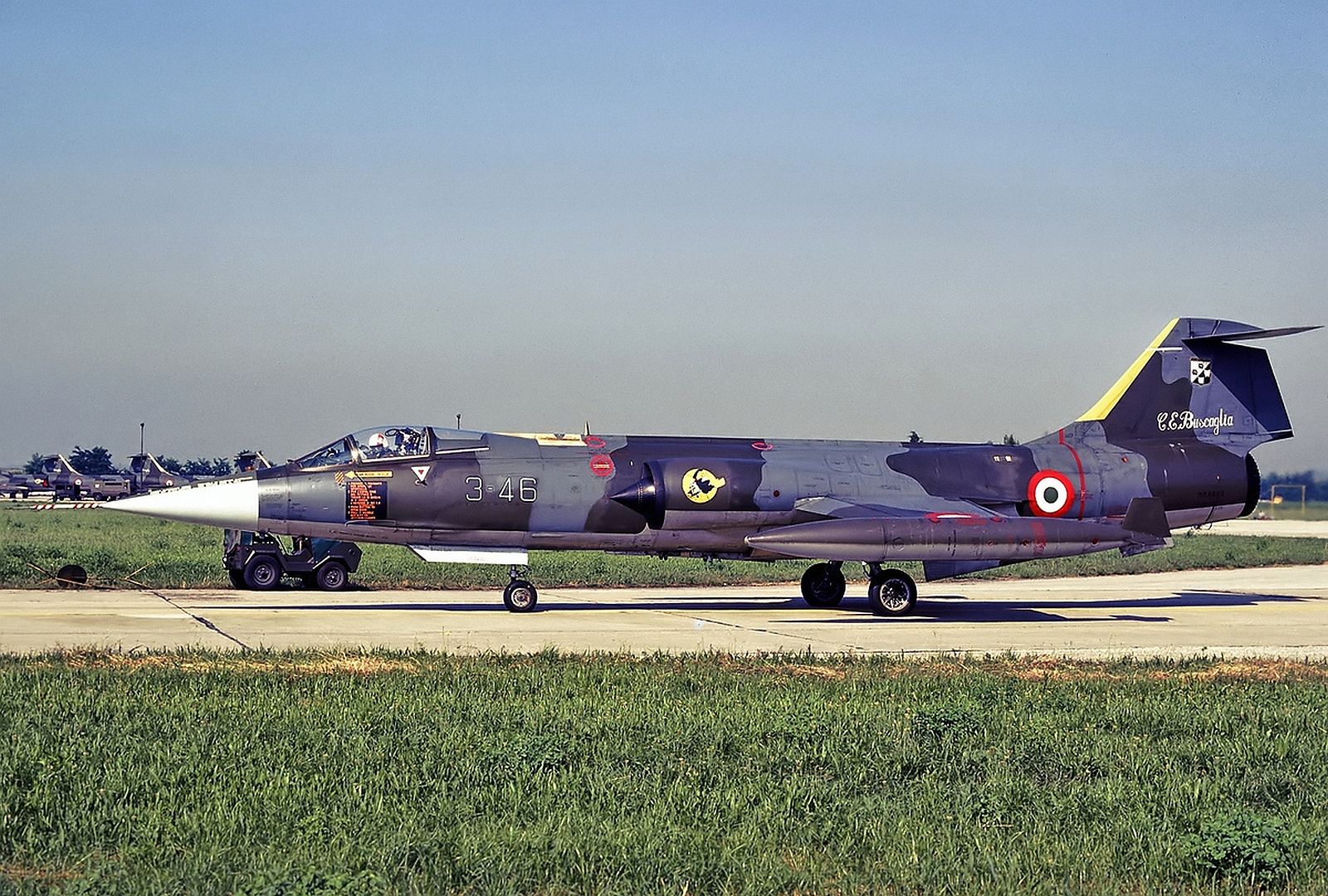
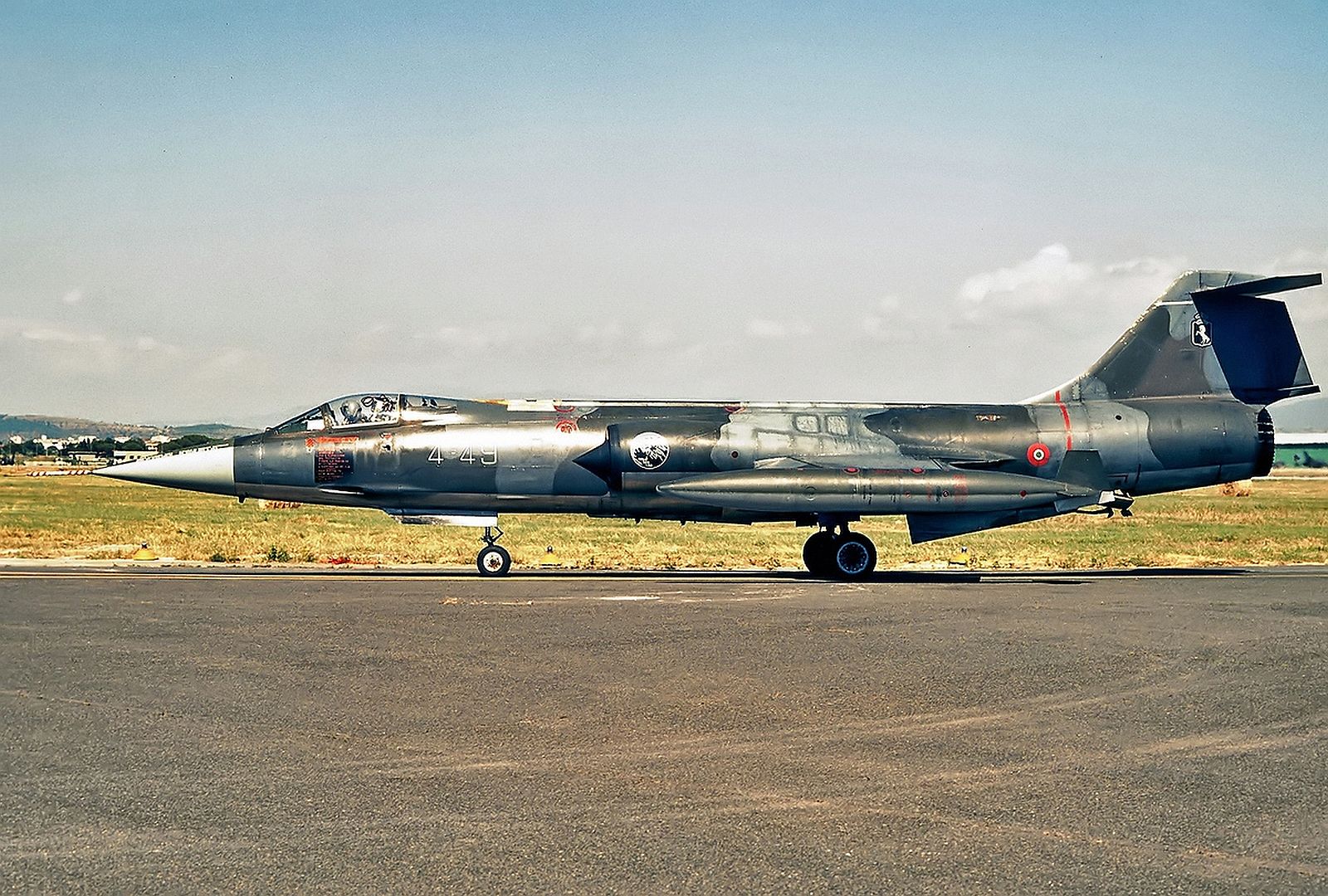
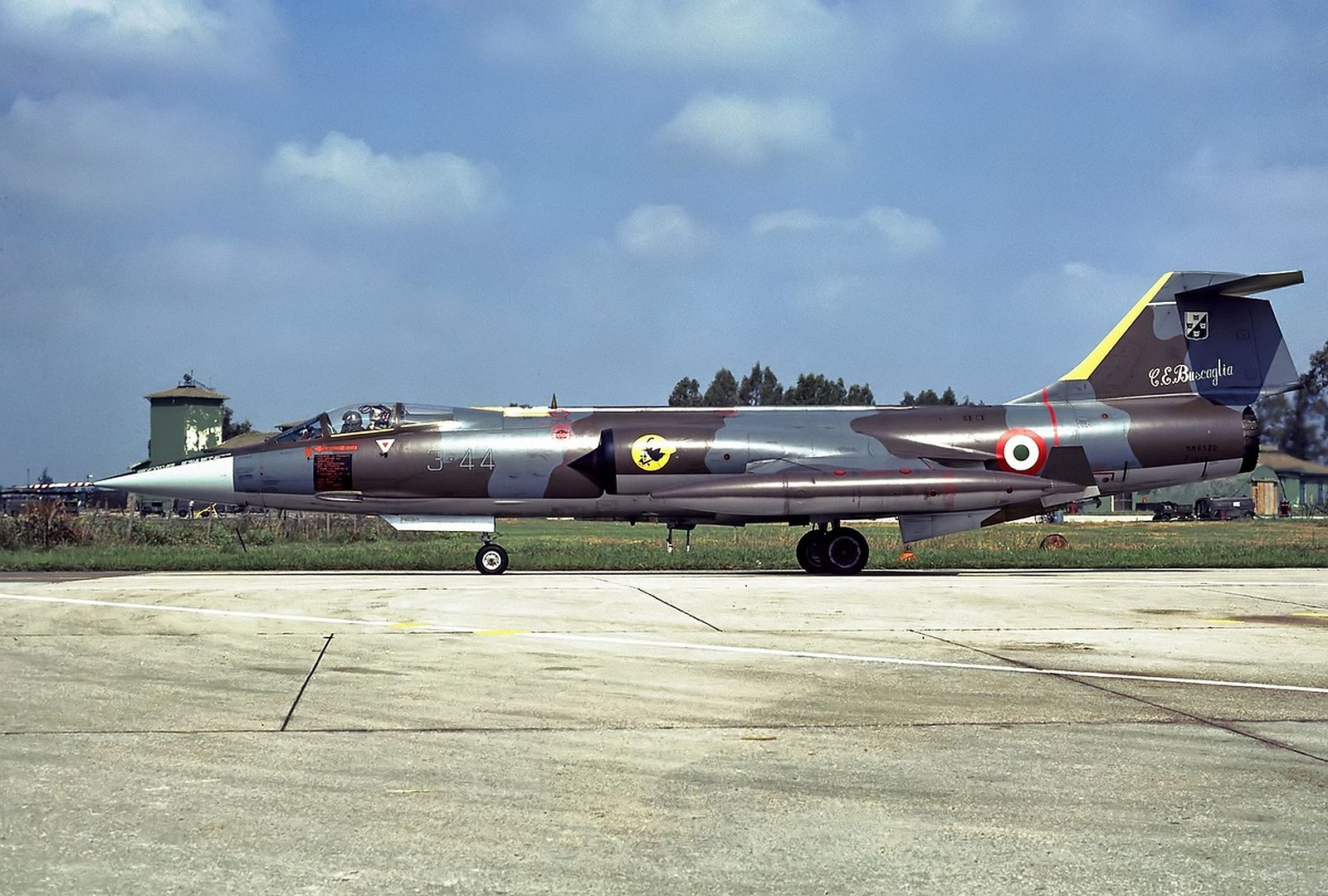
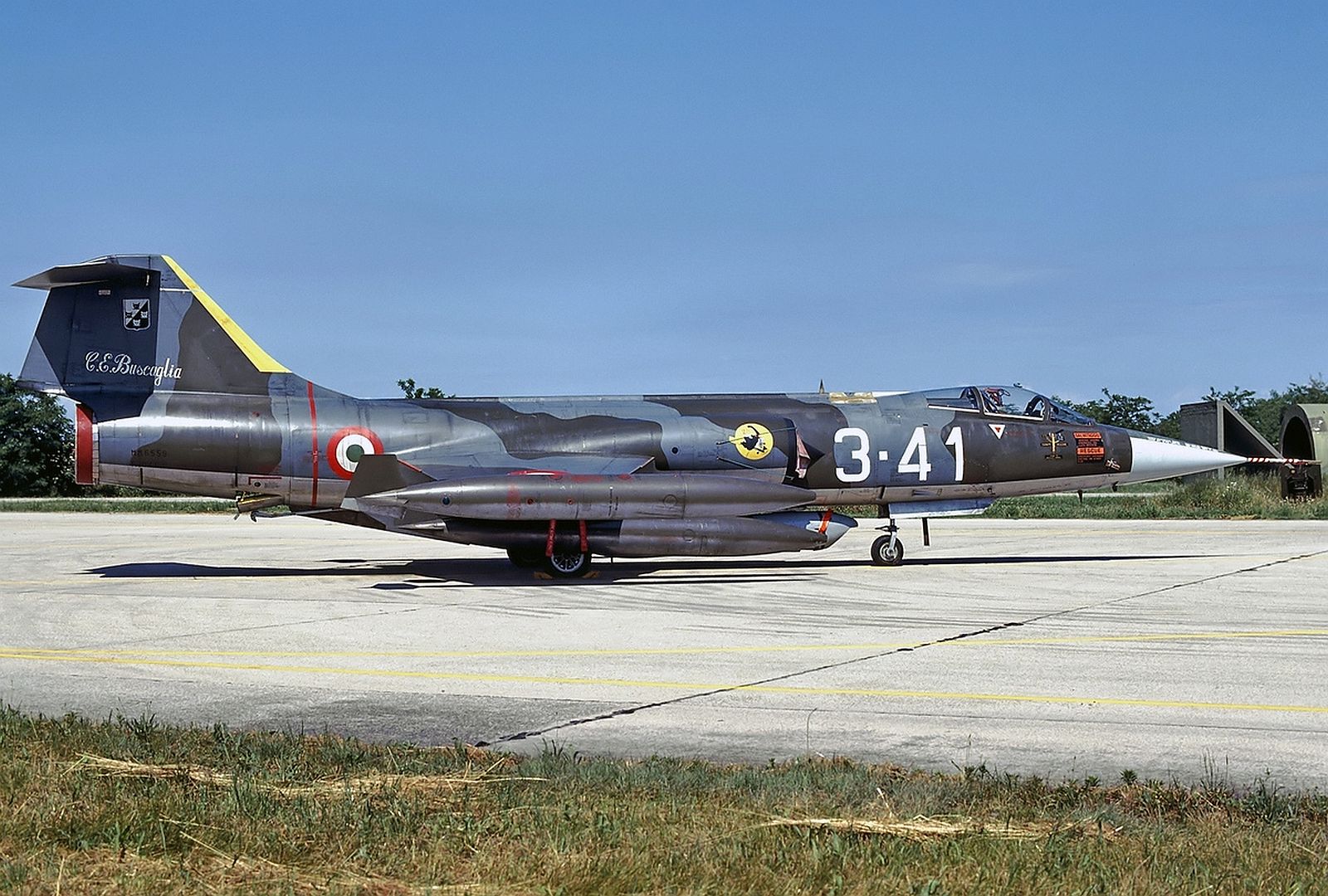
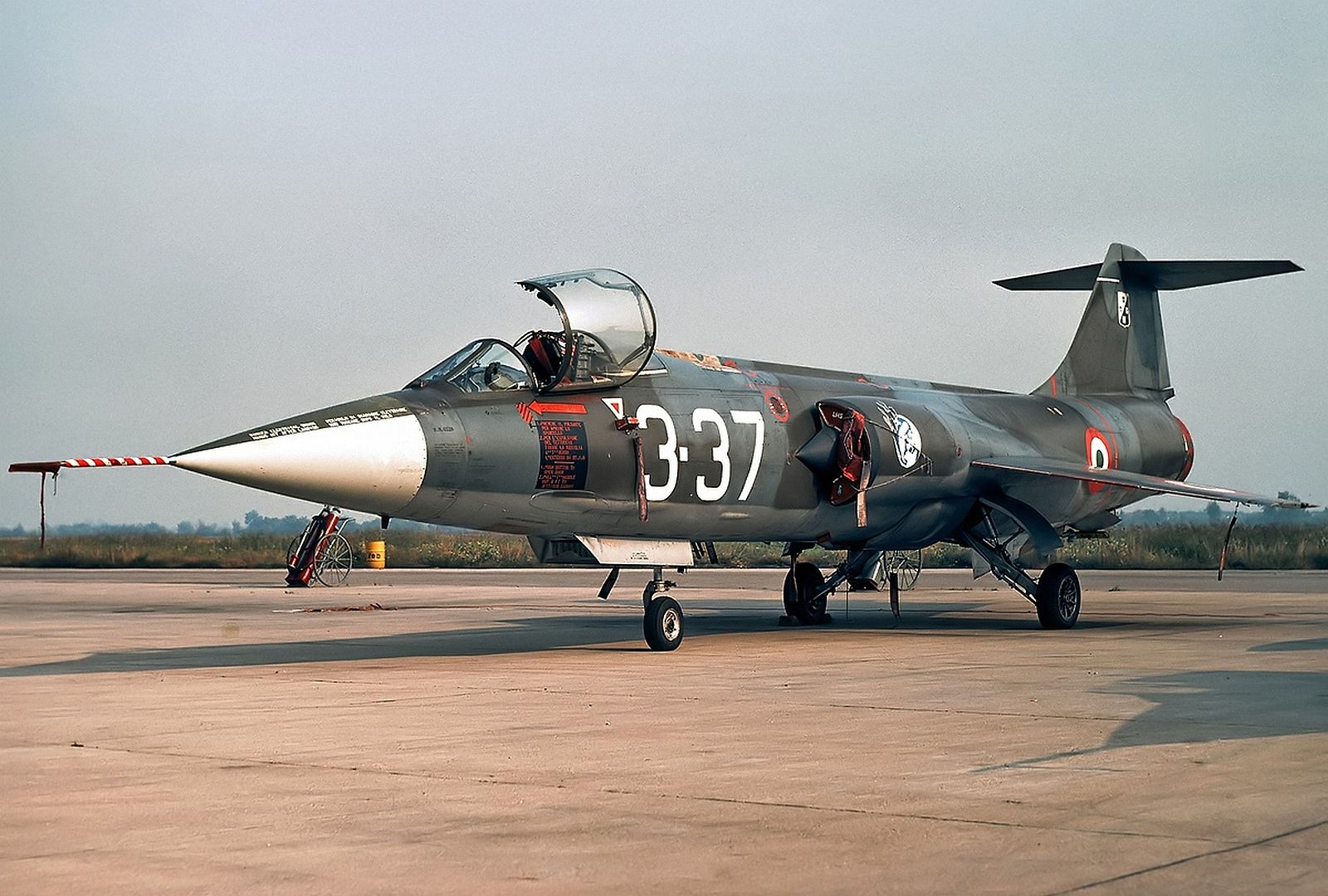



-
 Main AdminNorwegian F-104s
Main AdminNorwegian F-104s
Beginning in 1963, Norway acquired a batch of 21 new-build Starfighters, including 16 Lockheed-built RF-104Gs, 3 Canadair-built CF-104s, and two CF-104Ds. These deliveries were followed by two ex-Luftwaffe TF-104Gs from the Luftwaffe training center at Luke AFB in the US. A final batch of 20 ex-Canadian Armed Forces Starfighters, including 18 CF-104s and 2 CF-104Ds, was obtained in 1973, with the single-seaters kitted out for carriage of the Bullpup missile for anti-ship strike. That gave a total force of 43 Starfighters, including 37 single-seaters and 6 two-seaters.
The initial batch of Norwegian F-104s was originally flown in natural metal, with the aircraft gradually painted overall anti-corrosion light gray. All Canadian machines retained their overall green color scheme. All Norwegian Starfighters were retired in the early 1980s, to be replaced by the F-16. Some of the surviving F-104s were passed on to Turkey. The Norwegians only lost six of their Starfighters in accidents despite the relatively harsh climate, giving a reasonable loss rate of 13.6%.
Danish Starfighters
Denmark received an original batch of 25 Canadair-built F-104Gs and 4 Lockheed-built TF-104Gs beginning in 1965, with these aircraft provided under MAP funding. This was followed by a batch of 15 ex-RCAF CF-104s and 7 CF-104Ds beginning in 1971, with these machines overhauled and modified to F-104G / CF-104G standard in Denmark. The overhaul was based on kits supplied by Lockheed and included replacement of the older Lockheed C-2 ejection seat with the better Martin-Baker Mark 7 seat. The Danes acquired a total of 40 single-seaters and 11 two-seaters, or 51 in all.
The Danes operated their Starfighters in anti-corrosion gray until delivery of the ex-RCAF machines, when the entire fleet was repainted in Canadian wraparound green colors. Danish F-104s served into the mid-1980s, eventually being replaced by the F-16, with survivors passed on to Taiwan. Twelve Danish Starfighters were lost in accidents, an attrition rate of 23.5%.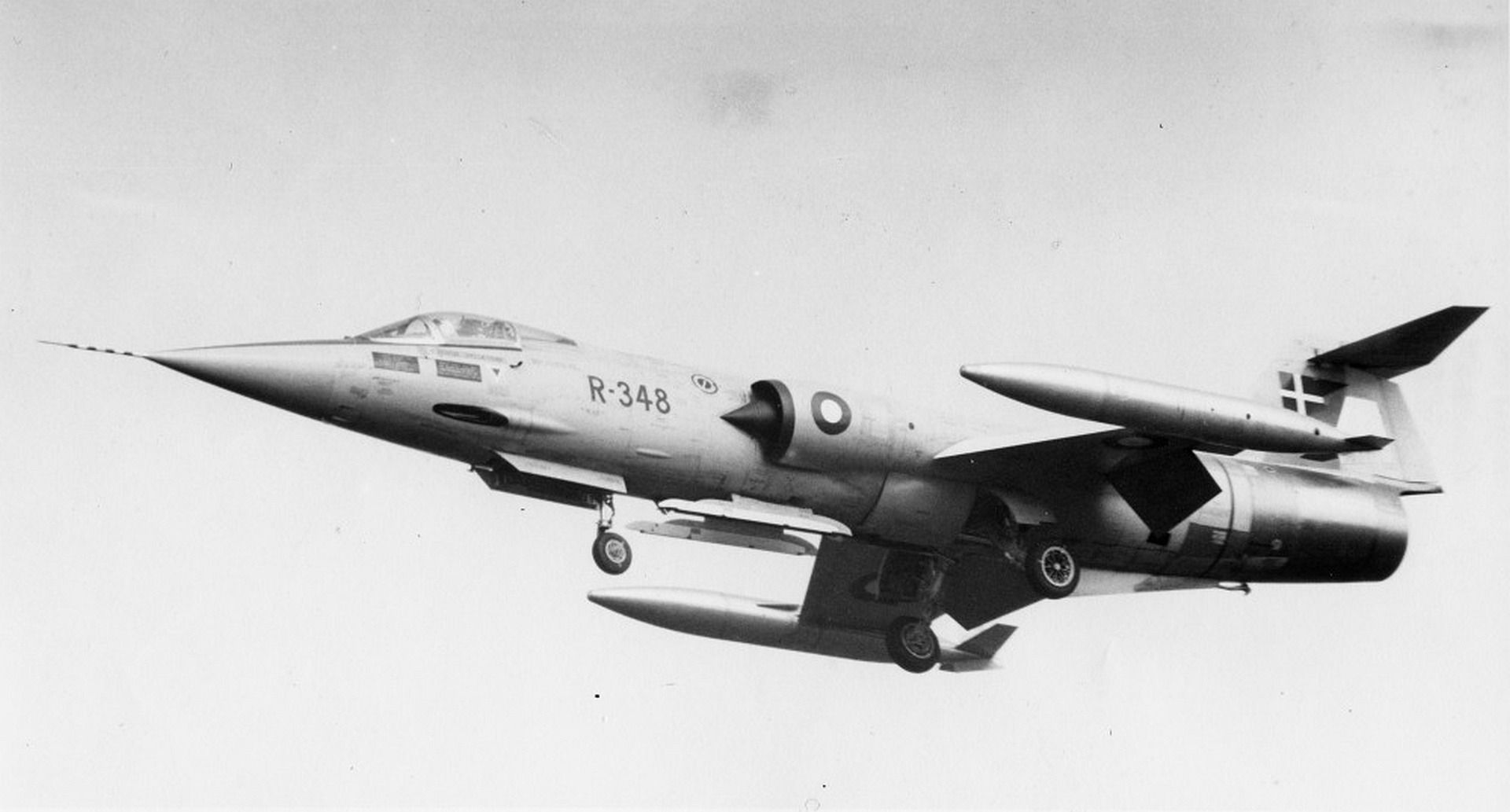
Spanish Starfighters
Spain's air force, the Ejercito del Aire (EdA), acquired 18 F-104Gs and 3 TF-104Gs from Lockheed through MAP beginning in 1965, with the Starfighter being given the designation of "C.8" in Spanish service. They replaced the F-86 and flew in either natural metal finish or anti-corrosion gray. Service life of Spain's Starfighters was short, with the type phased out in favor of the F-4 Phantom in 1972. The Spanish aircraft ended up in the hands of the Greeks and Turks, with the total split as evenly as possible between the two rivals.
The Spaniards were relatively minor operators of the type, but they had the major distinction of never having lost one of their 21 Starfighters in an accident during seven years of operations. No doubt generally sunny Spanish climate had something to do with it.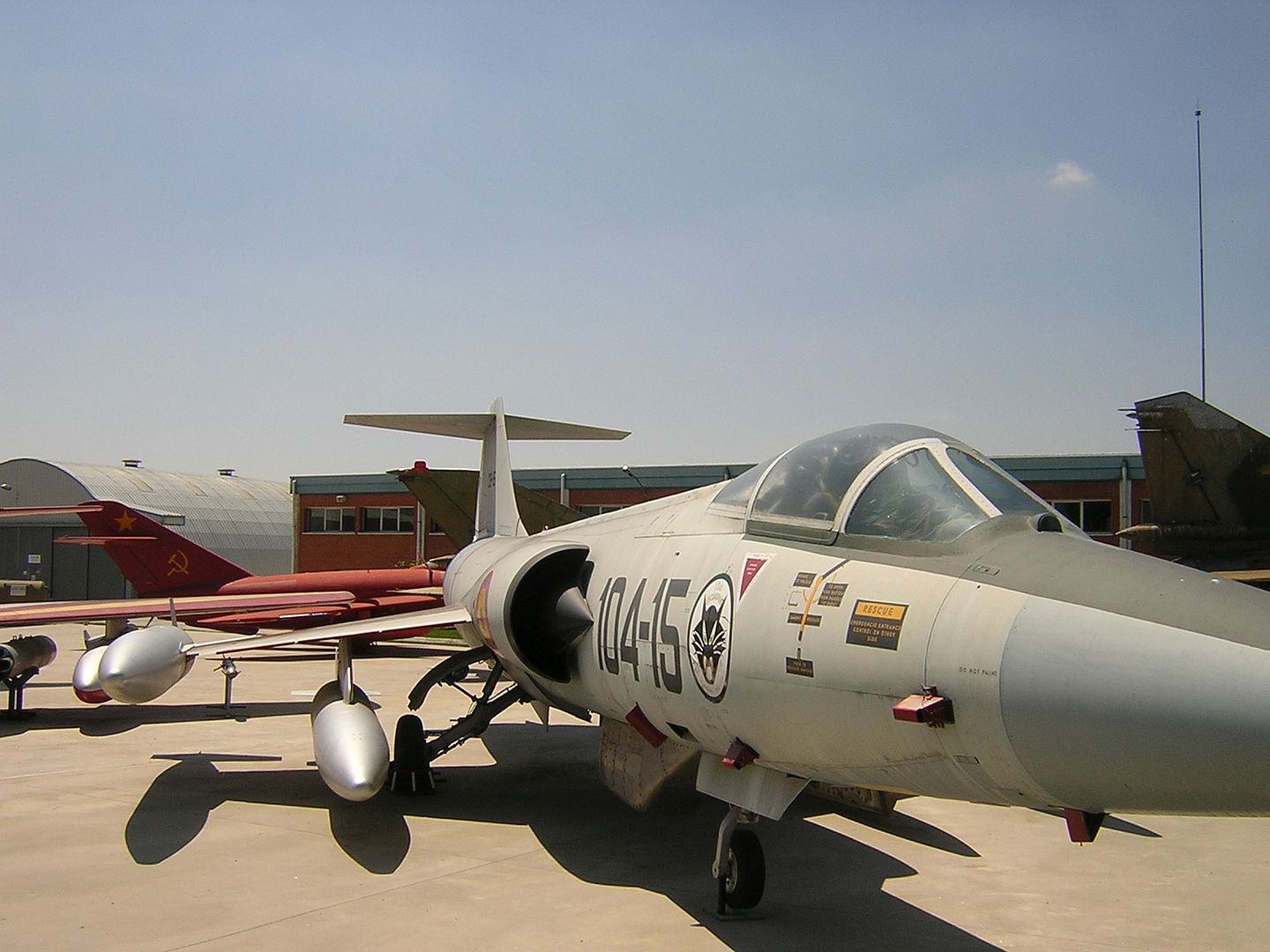
Greek Starfighters
Greece acquired an initial batch of 45 F-104Gs and 6 TF-104Gs under MAP funding, with these aircraft going into service in 1964. 35 of the F-104Gs were built by Canadair, while 10 of the F-104Gs and the 6 TF-104Gs were built by Lockheed. The Hellenic Air Force later acquired a large number of used machines from various sources:
9 F-104Gs and 1 TF-104G from Spain in 1972.
10 F-104Gs from the Netherlands in 1982.
38 F-104Gs, 22 RF-104Gs, and 20 TF-104Gs from West Germany. Three of the TF-104Gs were delivered in 1971, with the rest of the German Starfighters delivered from 1981 through 1988. Most of the German aircraft were ex-Marineflieger.
This gave 57 F-104Gs, 22 RF-104Gs, and 21 TF-104Gs handed down from other air arms, or a total of 100 aircraft. Some of the hand-me-downs were mothballed to be kept in reserve, or used as spares hulks.
Greek MAP Starfighters were flown in natural metal finish, but eventually the fleet ended up being given camouflage colors, with a disruptive pattern of olive drab / dark green / sand on top and light gray on the bottom. Greek Starfighters were finally phased out of service in the early 1990s. The accident attrition rate of the F-104 in Greek service is unclear.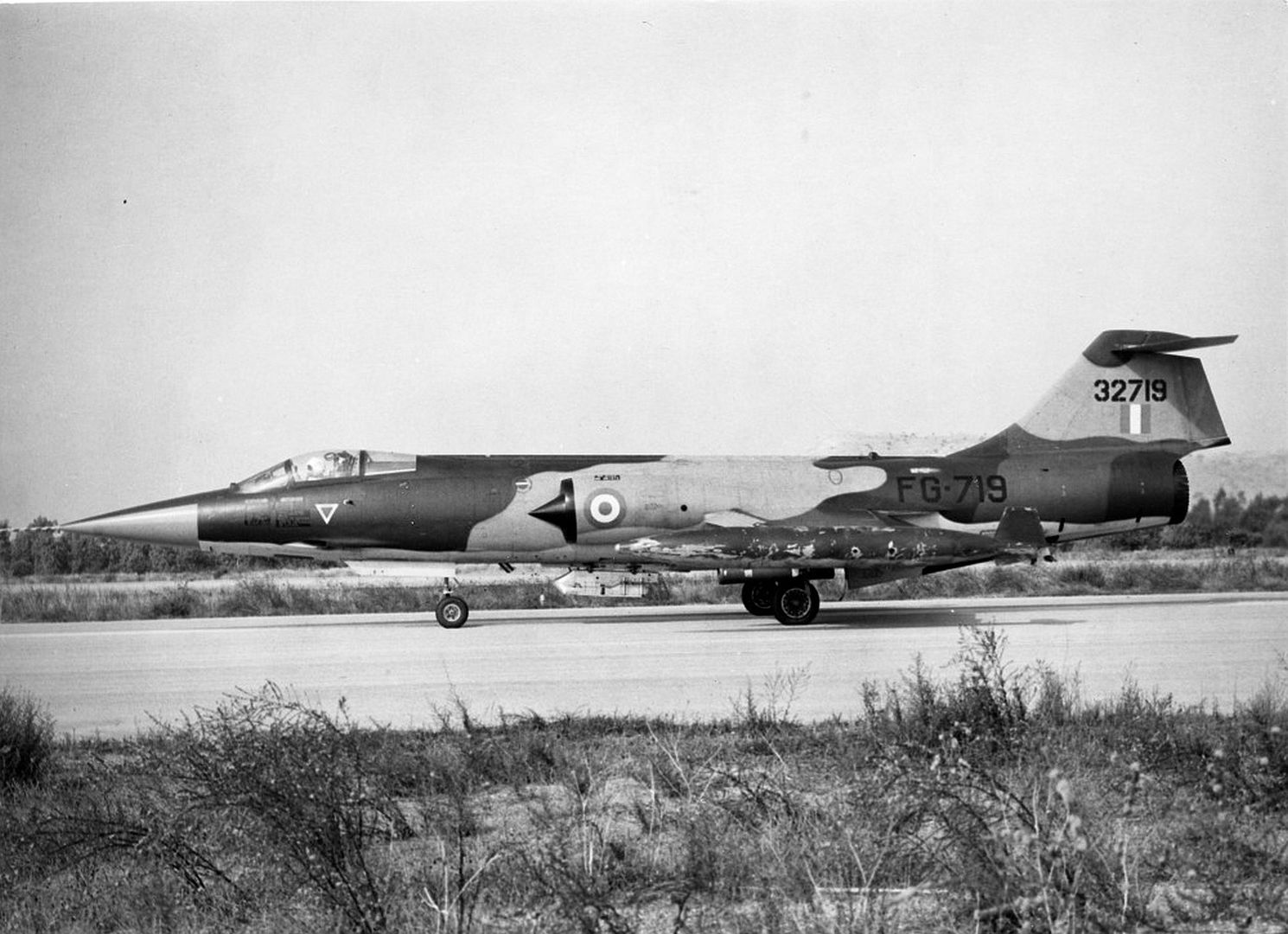
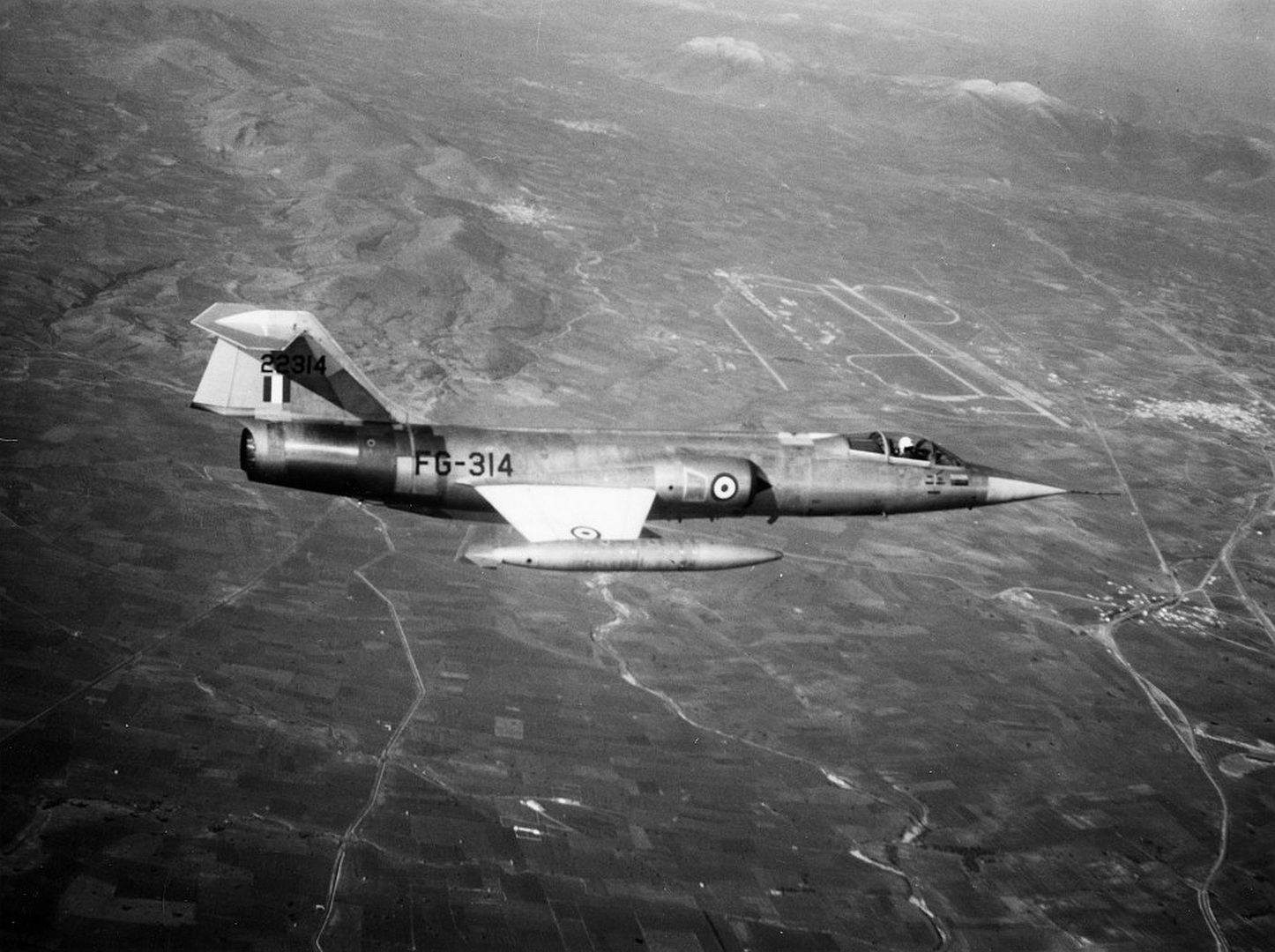
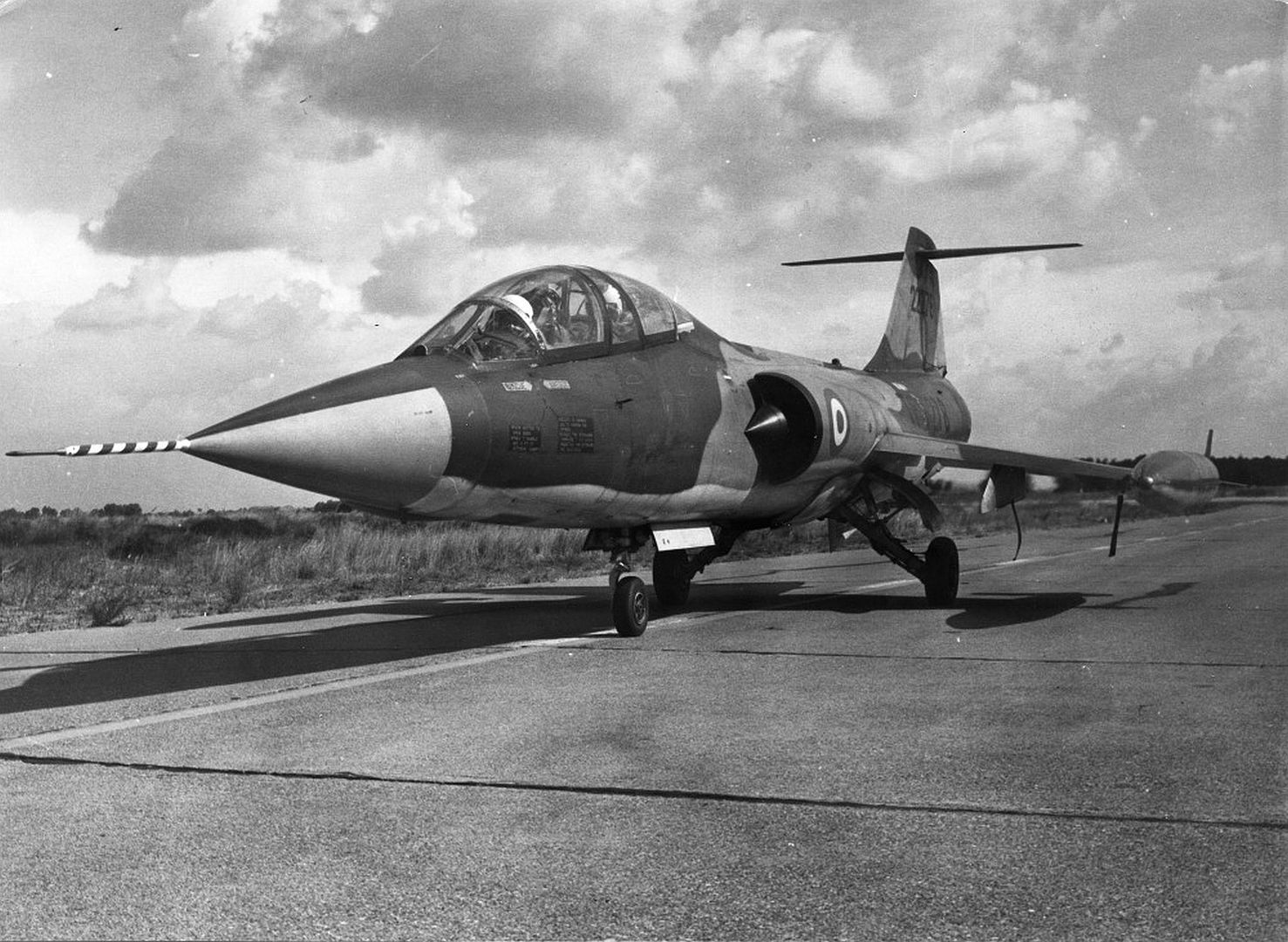
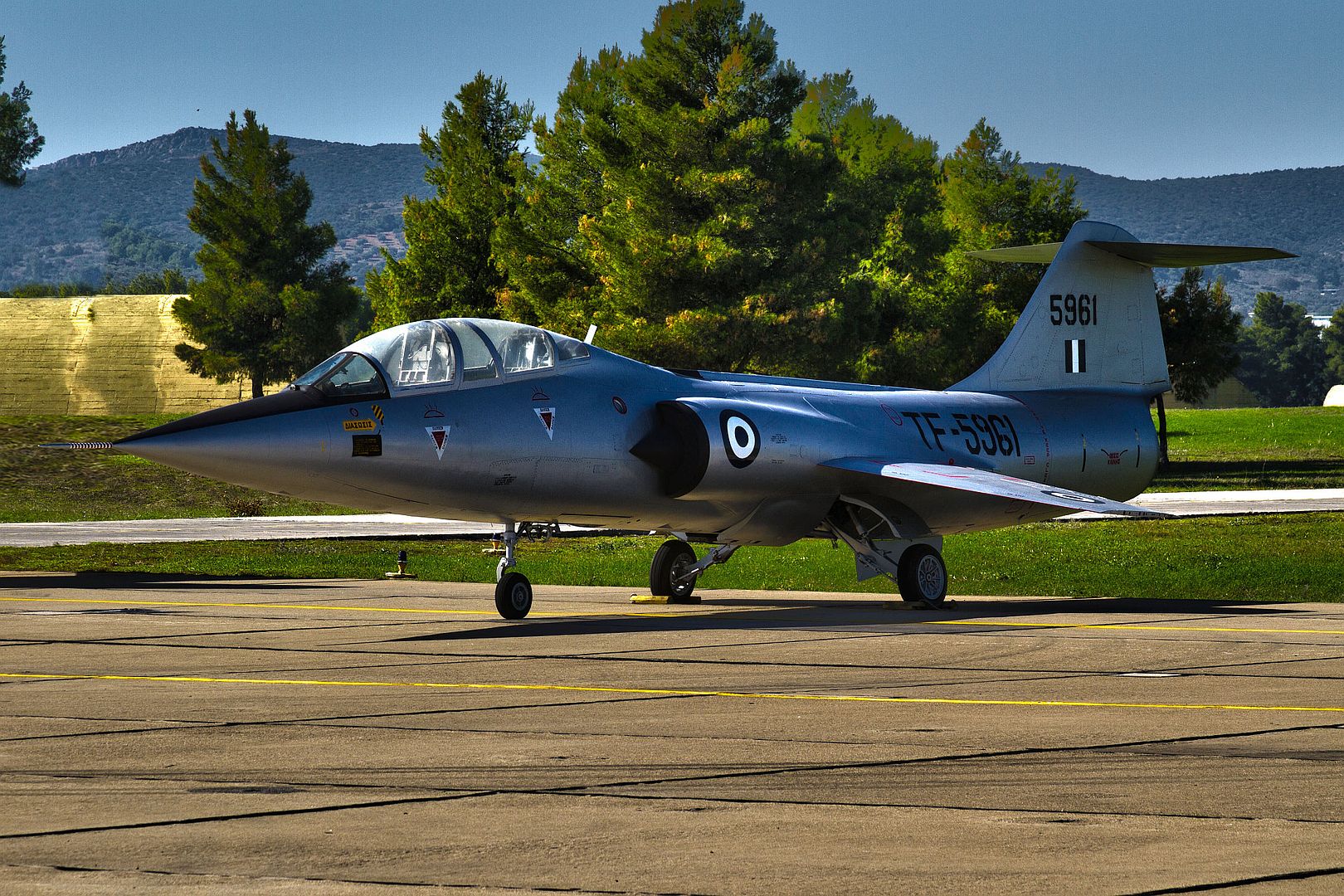

-
5 years agoSun May 16 2021, 07:50pmDuggy
 Main AdminTaiwanese Starfighters
Main AdminTaiwanese Starfighters
Taiwan was a major Starfighter user, with the aircraft obtained in a complicated series of steps. Deliveries appear to have been as follows:
24 ex-USAF F-104As and 5 F-104Bs were provided in 1960:1961, making Taiwan an early export user of the Starfighter.
46 F-104Gs and 8 TF-104Gs were obtained from Lockheed production under MAP, in 1964:1969. 21 RF-104Gs were also obtained in the same timeframe, though where they came from is not clear: some sources claim they were built by Canadair, while other sources claim Canadair never built any RF-104Gs.
6 ex-USANG F-104Ds were provided in 1975.
38 F-104Gs and 26 TF-104Gs were provided from Luftwaffe stock in 1983.
22 F-104Js and 5 F-104DJs were obtained from Japan in 1987.
15 F-104Gs and 3 TF-104Gs were obtained from Denmark, also in 1987.
Not all the aircraft received were functional, with some being used as spares hulks. Taiwanese F-104s were generally painted in overall anti-corrosion light gray, though a late in their careers this was modified to a two-tone subtle light gray mottled disruptive pattern.
All the early F-104A/B/Ds were withdrawn by the early 1980s, with some having earlier been sent to Pakistan in 1965 and Jordan in 1969 as discussed below. Some survived in Taiwanese service as drones or airfield decoys. The Starfighter remained in first-line service in Taiwan well into the 1990s, carrying modern AIM-9J all-aspect Sidewinders and the Taiwanese Sky Sword AAM. Apparently a few Starfighters were modified to a specialized reconnaissance specification with a long range optical (LOROP) camera in the nose.
There were plans to update Taiwanese Starfighters to the F-104 ASA standard, but it didn't happen. The last Starfighters, a handful of RF-104Gs, were retired at the end of the century. Data on Taiwanese Starfighter loss rates is unclear. Apparently they scored a few "kills" on mainlander MiG-19s during the late 1960s.

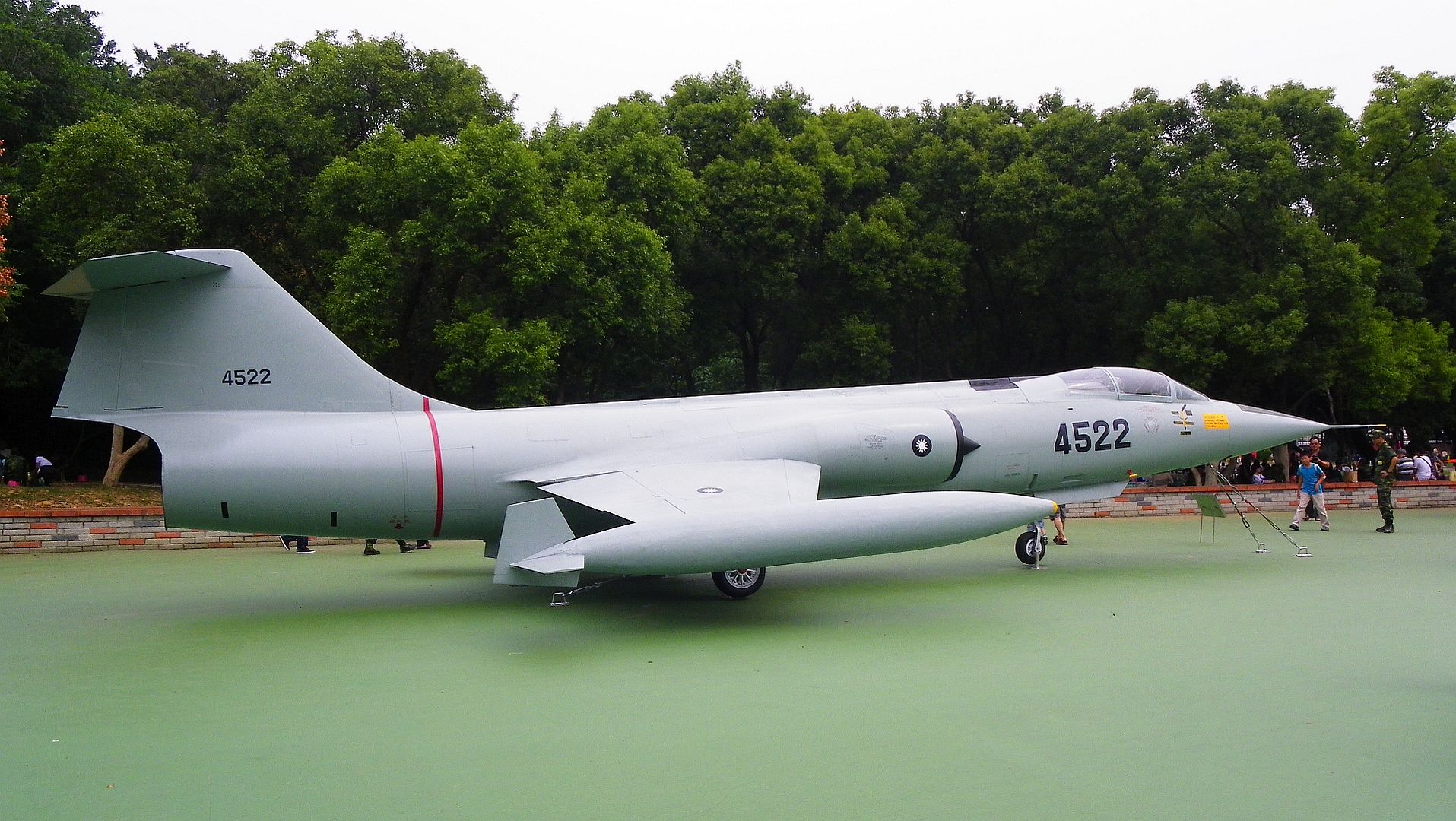
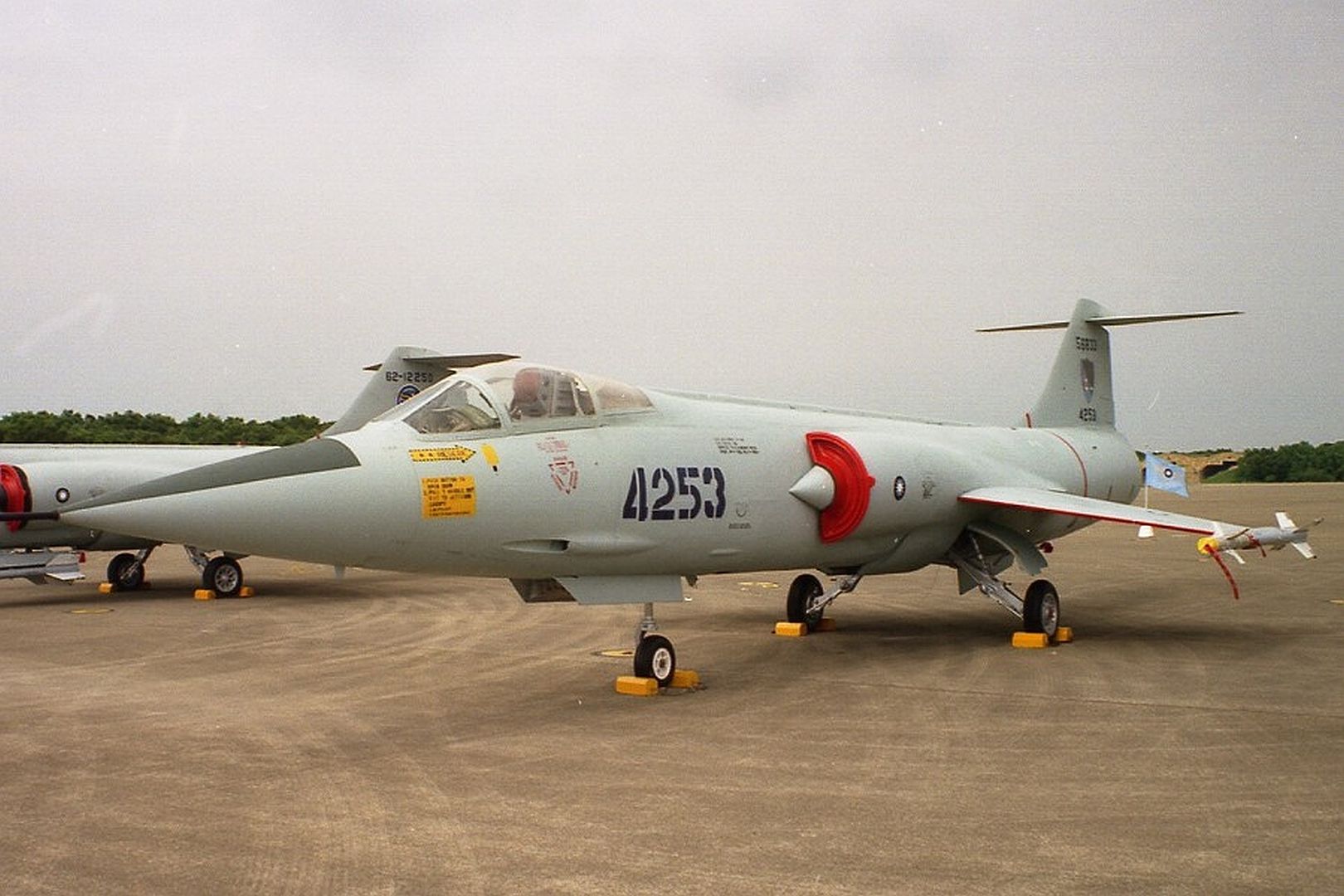
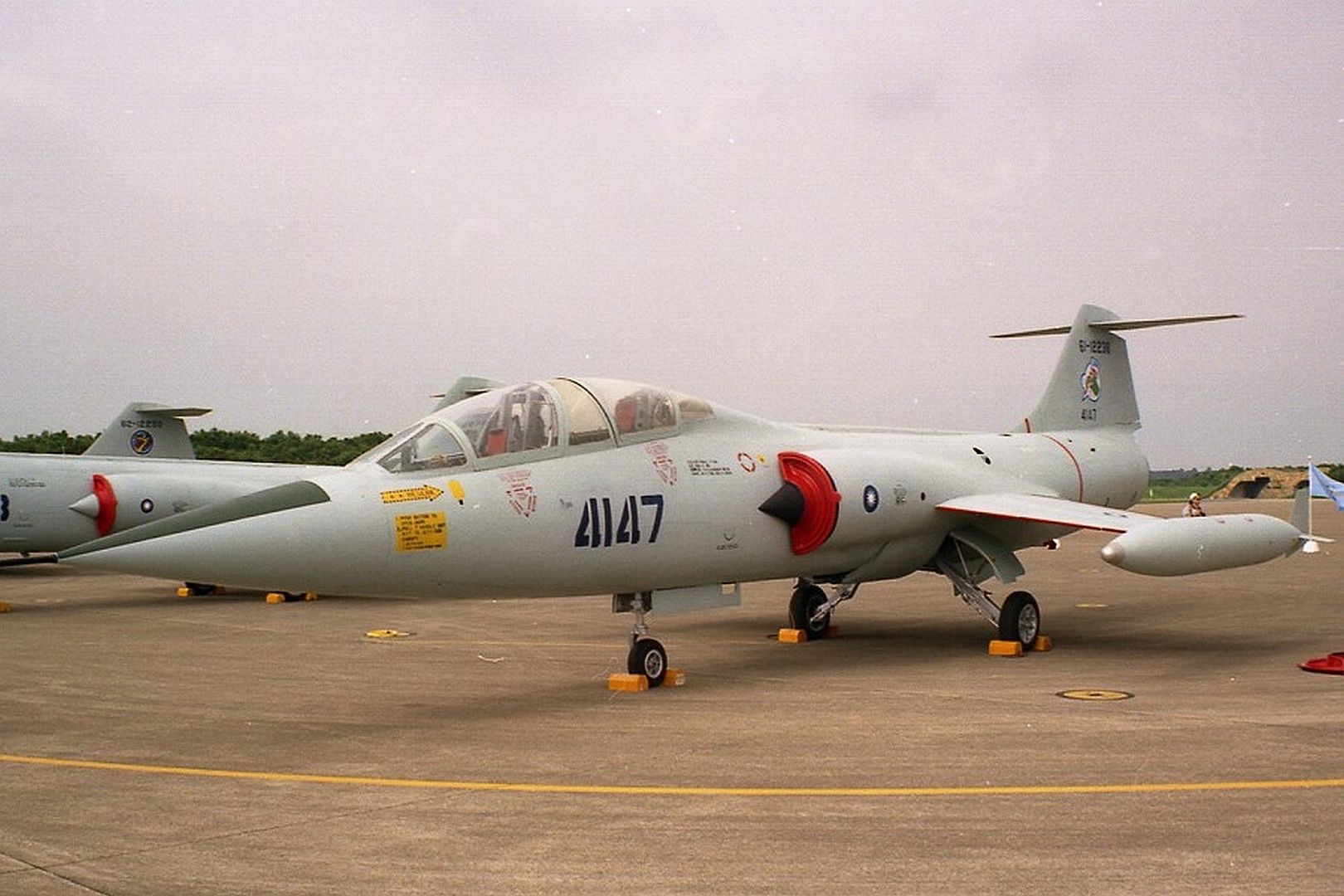

-
 Main AdminPakistani Starfighters
Main AdminPakistani Starfighters
Pakistani Starfighters fought in the 1965 war with India, and the Pakistanis claim it acquitted itself well, with four kills and two losses, though Indian sources give fewer kills and higher losses. Some sources claim the Indians were very intimidated by the speedy F-104, calling it the "Badmash (Hoodlum)". Two F-104As were passed on from Taiwan to replace the losses, and there are rumors that the Pakistanis also obtained a new-build RF-104G from Lockheed production. However, after 1965 the US embargoed further shipments of Starfighters to Pakistan, and the Starfighter force withered.
Pakistani F-104s fought in the 1971 war with India as well, assisted by Jordanian Starfighters. If the Indians had indeed been intimidated by the F-104 in the 1965 war, they weren't six years later. Even the Pakistanis admitted they didn't do so well, with up to seven losses and relatively few kills. Apparently the main deciding factor was that the F-104 was simply massively outnumbered.
The Pakistanis admitted that the maneuverability of the type left something to be desired in combat, though this seems a bit puzzling. The F-104 was an aircraft suited to "hit-&-run" tactics, and was of course going to suffer in a turning fight because of its wide turn radius; why anyone would have wanted to get into a turning fight with it is hard to understand, unless it was forced on pilots by the tactical situation. Some sources claim the MiG-21 had an edge in maneuverability over the Starfighter, but the MiG-21 had been designed with roughly the same design goals in mind as the F-104, and the MiG's maneuverability was nothing to write home about, either. In any case, Pakistan finally phased the Starfighter out in the mid-1970s, replacing it with French Dassault Mirage 5 fighters.
-
 Main AdminTurkish Starfighters
Main AdminTurkish Starfighters
The Turks were major Starfighter operators. A portion of the Turkish fleet was new-build machines. The first batch, consisting of 44 F-10Gs, 2 RF-104Gs, and 6 TF-104Gs obtained through MAP from Lockheed and Canadair production, was delivered beginning in 1963. The second batch consisted of 40 Italian-built F-104S Starfighters, delivered in the mid-1970s.
However, most Turkish aircraft were hand-me-downs from NATO air forces, with acquisitions roughly as follows:
9 F-104Gs and 2 TF-104Gs from Spain in 1972.
18 F-104Gs from Belgium in 1981:1983.
21 F-104Gs, 22 RF-104Gs, and 10 TF-104Gs from the Netherlands in 1980:1984.
3 CF-104s, 9 RF-104Gs, and 1 TF-104G from Norway in 1981.
137 F-104Gs and 33 TF-104Gs from West Germany in 1980:1988.
46 CF-104s and 6 CF-104Ds from Canada in 1986.
Some of the aircraft were overhauled before delivery, some were simply used as spares hulks. The Turks tended to keep the color schemes of the original users, resulting in a patchwork of paint jobs. Apparently Turkish Starfighters never saw any real combat. If they had, since the most probable adversary was the Hellenic Air Force, that would have led to the interesting prospect of Starfighter-on-Starfighter dogfights. Numbers of losses in accidents are unclear, but appear to have been towards the high side of the curve. The Turks retired their F-104s in the mid-1990s, the type being finally replaced by the F-16.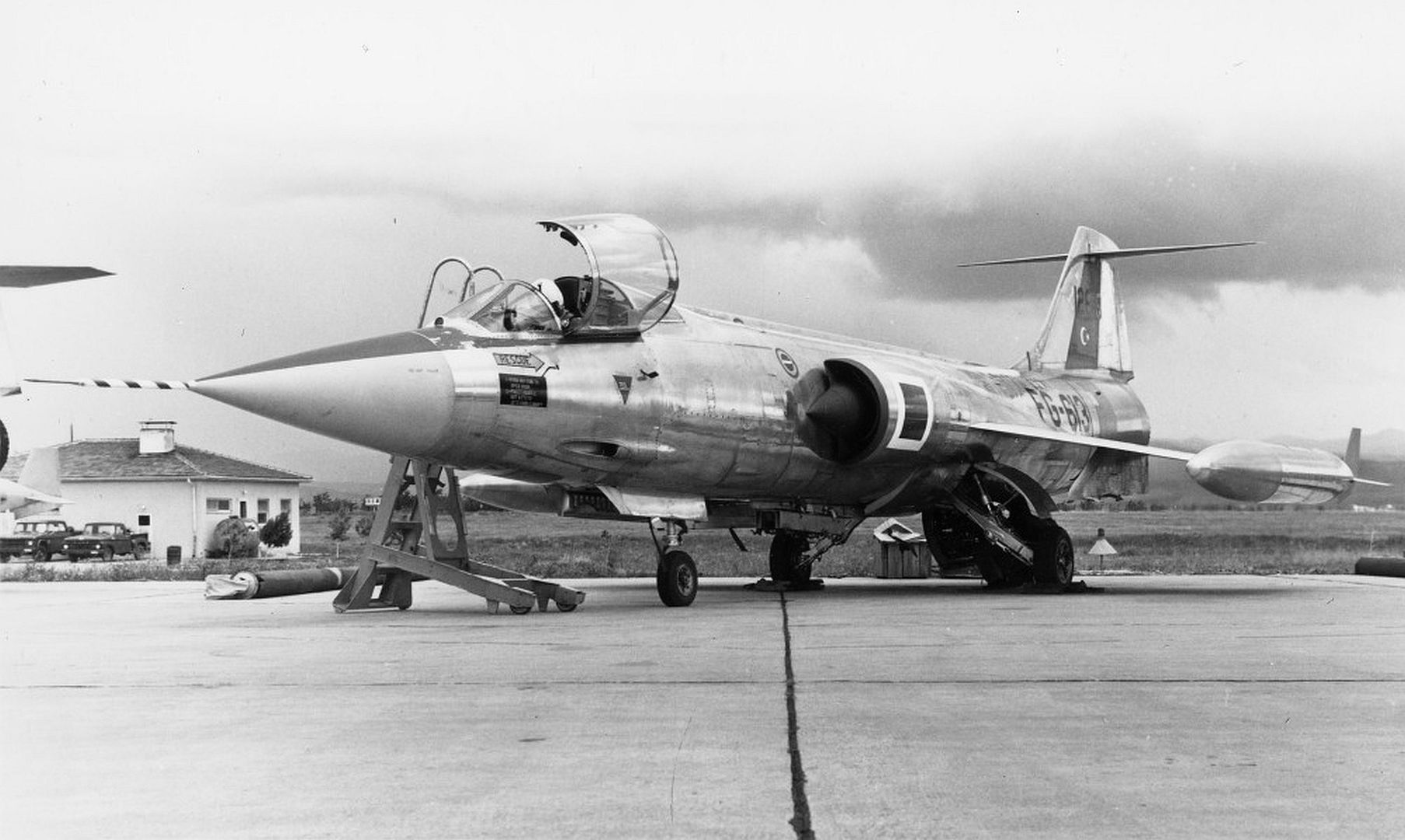
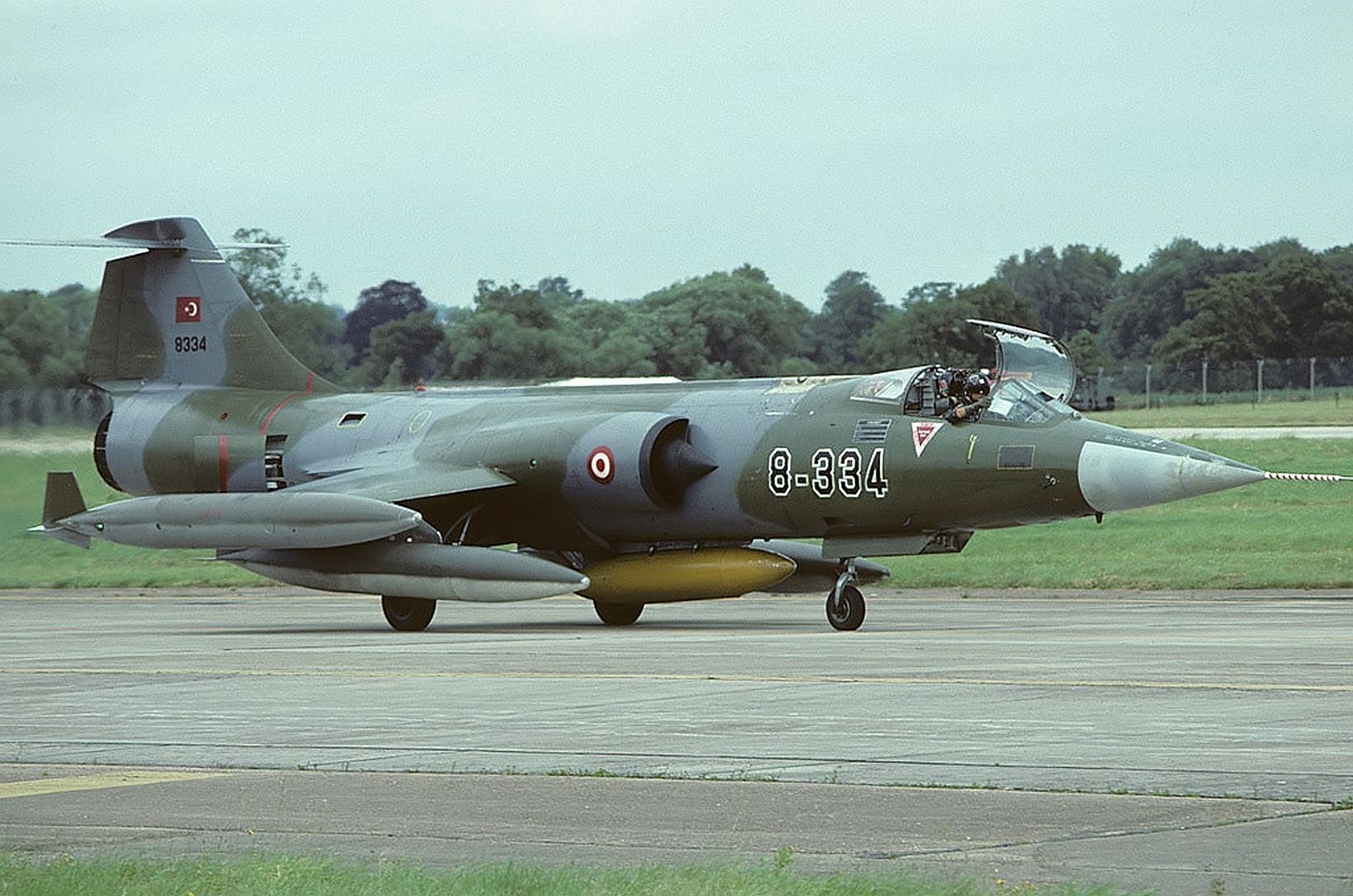
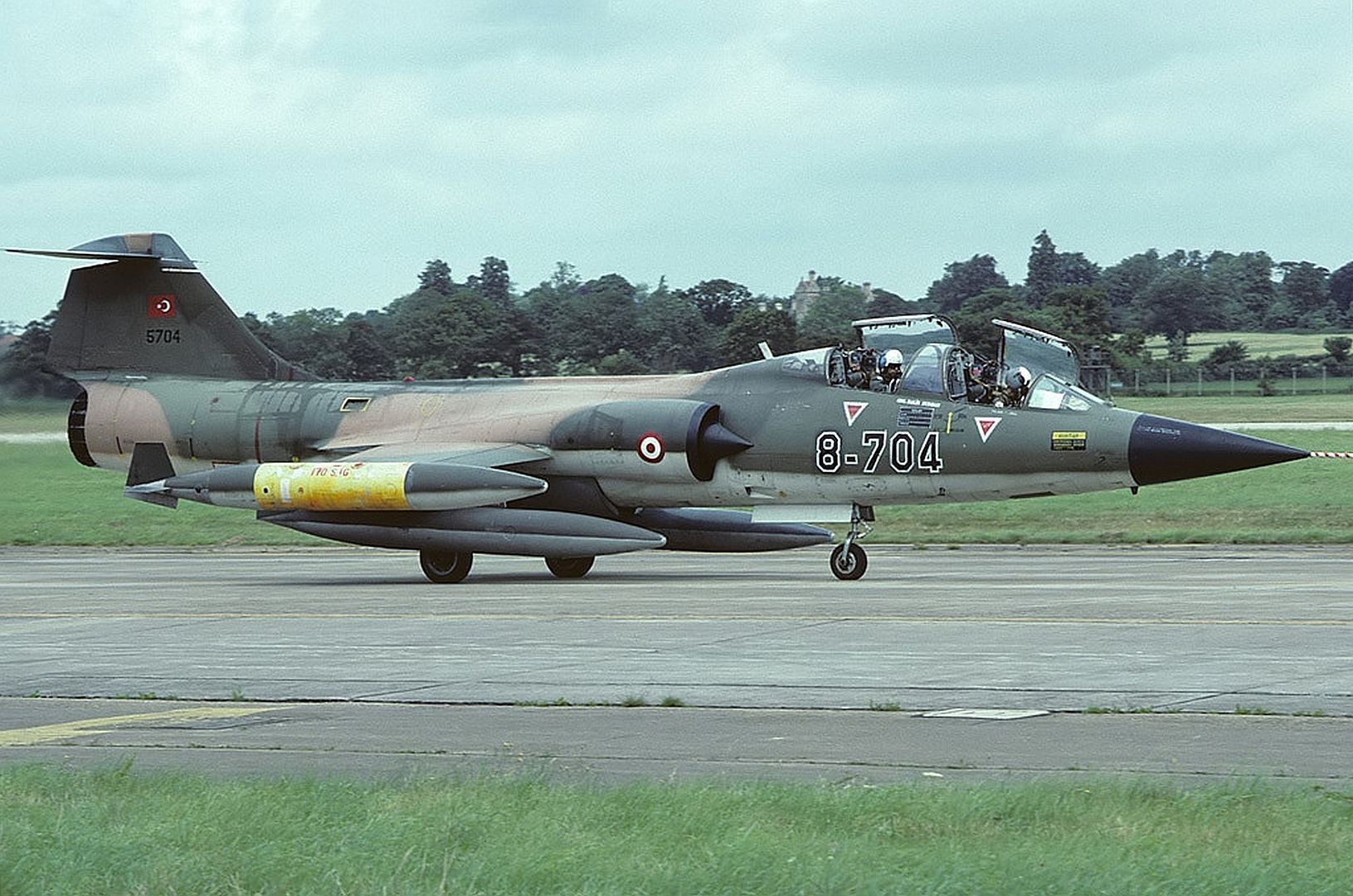
-
 Main AdminJordanian Starfighters
Main AdminJordanian Starfighters
In the later half of the 1960s, Jordan obtained about 18 ex-USAF F-104As and 6 ex-USAF F-104Bs, with initial deliveries just in time for the 6-Day War of June 1967. Most of Jordan's air force was destroyed on the ground during that conflict, but the Starfighters survived since Jordanian pilots didn't know how to fly them well enough at the time to use them safely in combat, and they were accordingly sent to safe haven in Turkey.
After a lapse while the aftermath of the war was sorted out, the deliveries of ex-USAF Starfighters were completed, to be followed by a batch of F-104As from Taiwan. Apparently the Jordanians were instructed by Pakistani pilots, and in return for the courtesy, as mentioned above Jordanian Starfighters fought in the 1971 Indo-Pakistan War, suffering several losses at the hands of the Indian Air Force.
Jordanian Starfighters were originally delivered in anti-corrosion overall light gray, to later acquire a dark green / olive / tan disruptive camouflage pattern on top with light gray underneath. Jordanian Starfighters were retired from operational service in the late 1970s, being replaced by French Dassault Mirage F1 fighters. Some of the old Starfighters ended up as airfield decoys, at least in some cases "dummied up" to resemble the Mirage F1.
-
 Main AdminCivilian Starfighters
Main AdminCivilian Starfighters
The Starfighter established many flight records, some established by civilians. Lockheed retained a single TF-104G as a demonstrator, with the aircraft given the assertive Cold War name of FREE WORLD DEFENDER. It was painted in neat overall slate-blue colors with white markings. This machine was used by aviatrix Jackie Cochrane to set three world speed records, and also used in 1963 by Tony Levier's daughter Toni to become the "world's fastest teenager". The TF-104G was later passed on to the Dutch.
Air enthusiast Daryl Greenamyer even built his own Starfighter, the bright red-and-white "Red Baron" or "F-104RB", over a 12-year period from a CF-104 airframe that he stripped of combat gear and fitted with an uprated J79 engine from a Phantom, making it a real "speed demon". On 24 October 1977, he set a world's record with the Red Baron, flying it over a frightening low-level 3-kilometer (1.86-mile) course at an average speed of 1,590.45 KPH (988.26 MPH). He was preparing for an altitude record in February 1978 when the landing gear didn't deploy properly; he punched out, and the Red Baron fell to earth.
A few two-seat F-104s also ended up in private hands for use in test pilot training, flight test, and so on. Details are unclear, but at least a few Starfighters are flying on the airshow circuit, and may be lingering in other civilian uses.
* The US National Aeronautics & Space Administration was very fond of the speedy Starfighter as a flight test program, and kept it in use long after it had been phased out of general USAF service.
The NASA fleet was founded in August 1956 when the agency, then NACA, received the seventh YF-104A. This machine served NASA until 1975, when it was passed on to the Smithsonian National Air & Space Museum. This aircraft was followed by acquisition in 1963 of three new-build F-104Gs for use as chase aircraft and test platforms. These machines were given the designation of "F-104N", the "N" of course standing for "NASA". They were apparently pretty much stock F-104Gs stripped of combat gear; NASA tinkered with some of them quite a bit for special projects.
One was lost in an infamous accident on 8 June 1966, when it was being used as part of a photoshoot with a North American XB-70 Valkyrie experimental supersonic bomber. The F-104N got caught in a vortex behind the XB-70 and slammed into one of the bomber's two tailfins, tearing it off and causing the Starfighter to explode into a ball of flame. The F-104N pilot, well-known test pilot Joe Walker, was killed; the XB-70 fell to earth, with the pilot, Alvin White, surviving, while the copilot, USAF Major Carl Cross, was killed.
NASA later received two more single-seaters, apparently retired F-104Gs, as well as two ex-Luftwaffe TF-104Gs obtained in 1975. All were designated "F-104Ns", no matter what actual variant they were. NASA liked to paint their aircraft in a distinctive spiffy color schemes, ultimately white overall with blue "daggers" running down each side of the fuselage. NASA retained a single-seater and a two-seater well into the 1990s.
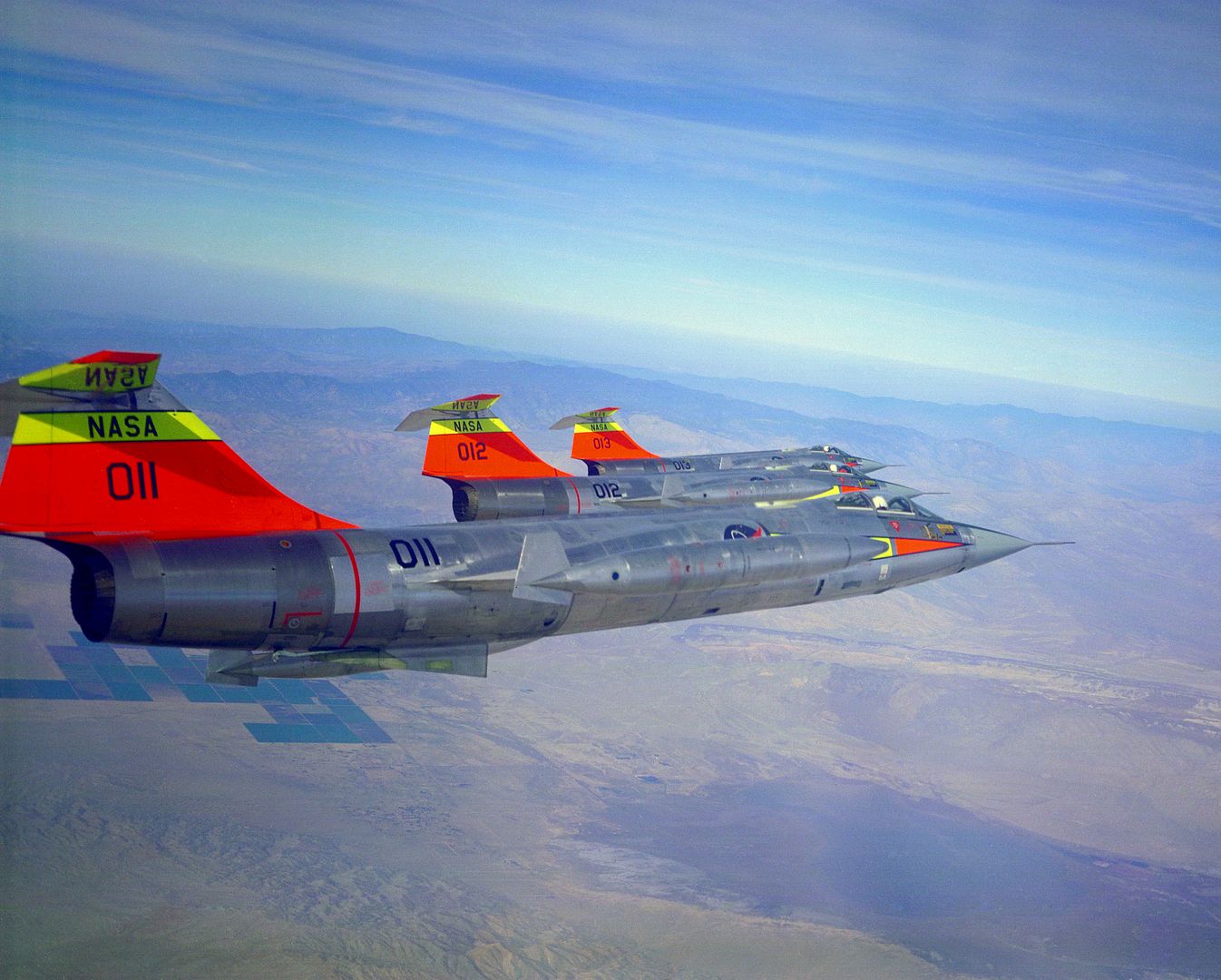
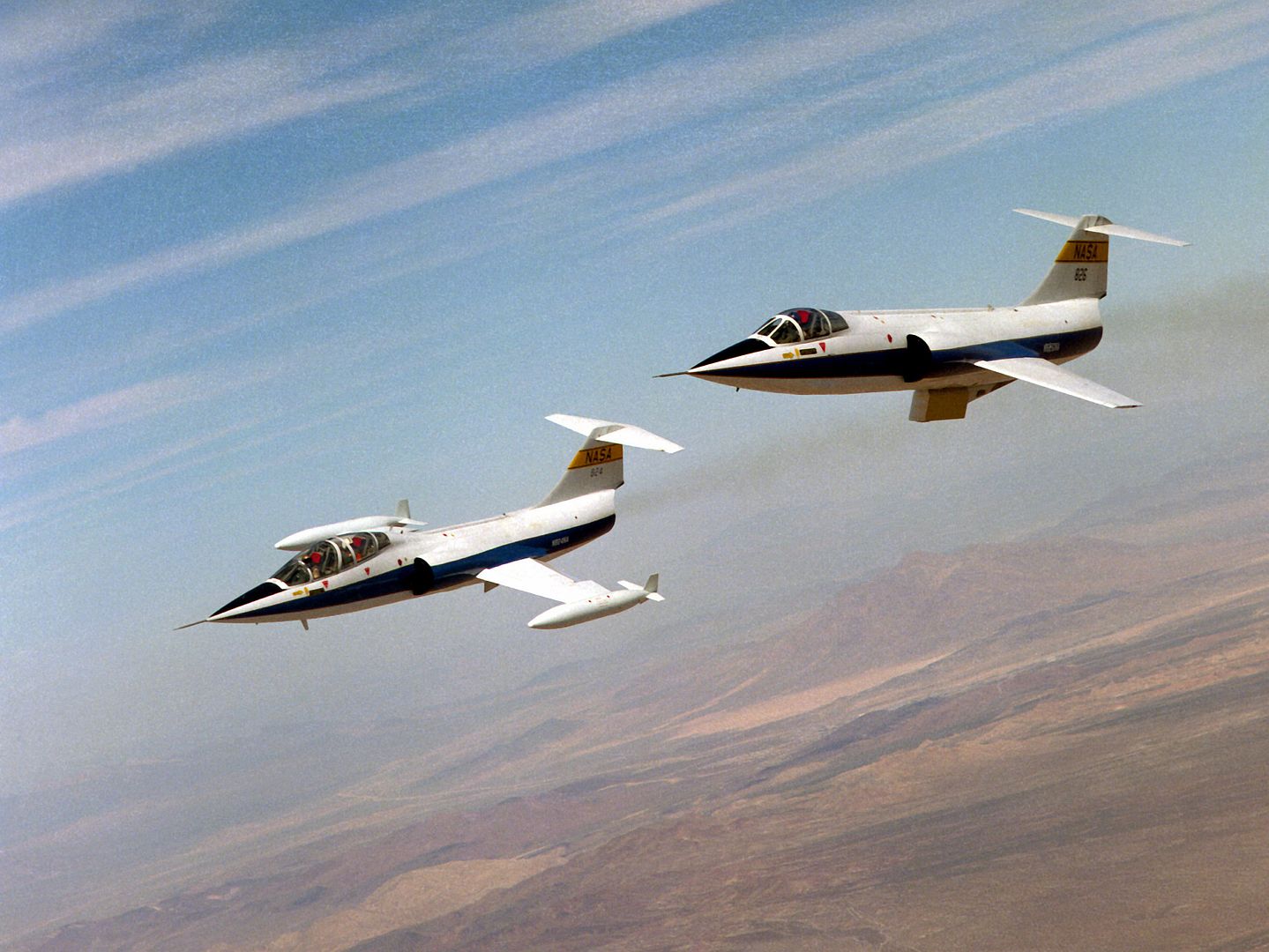
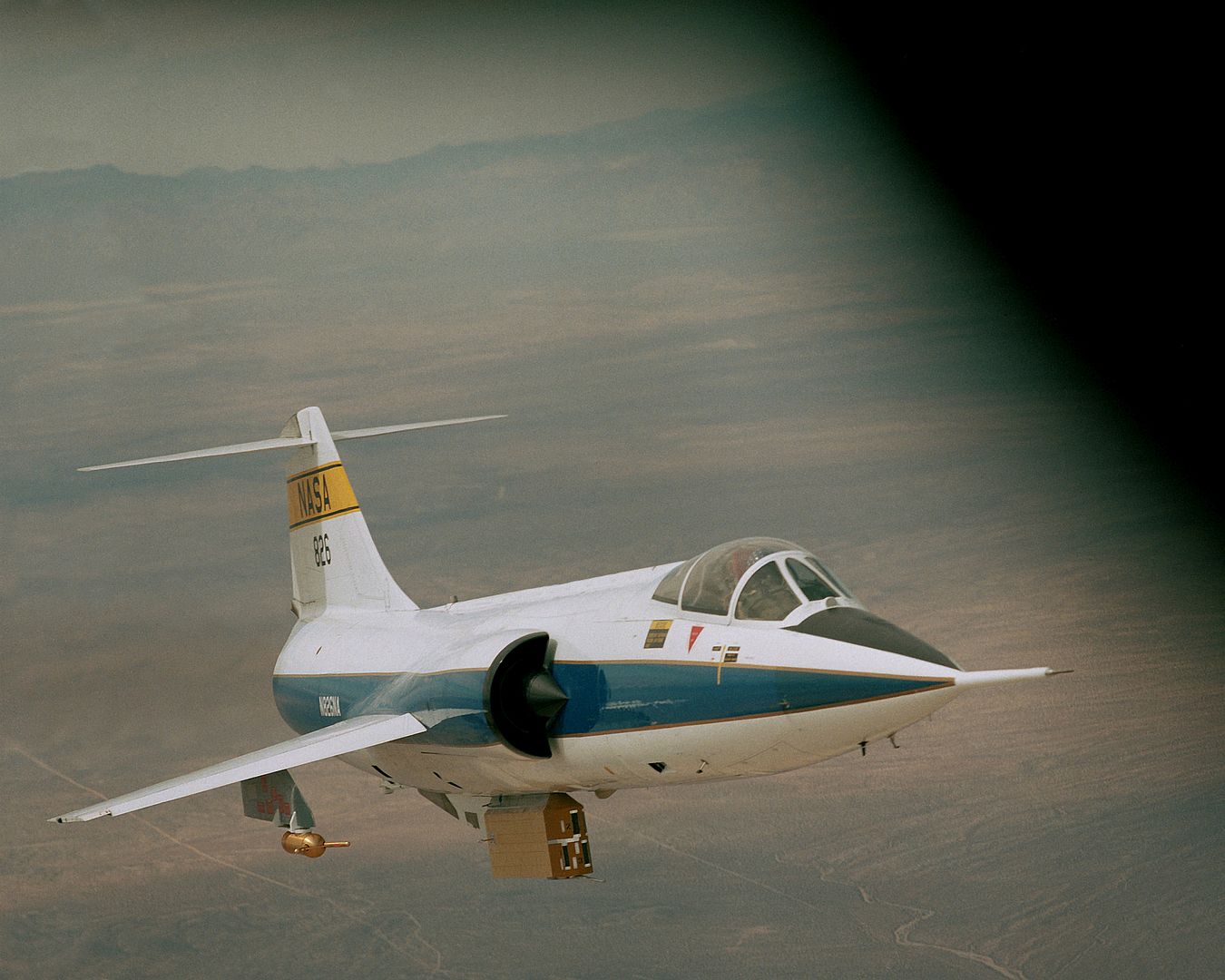
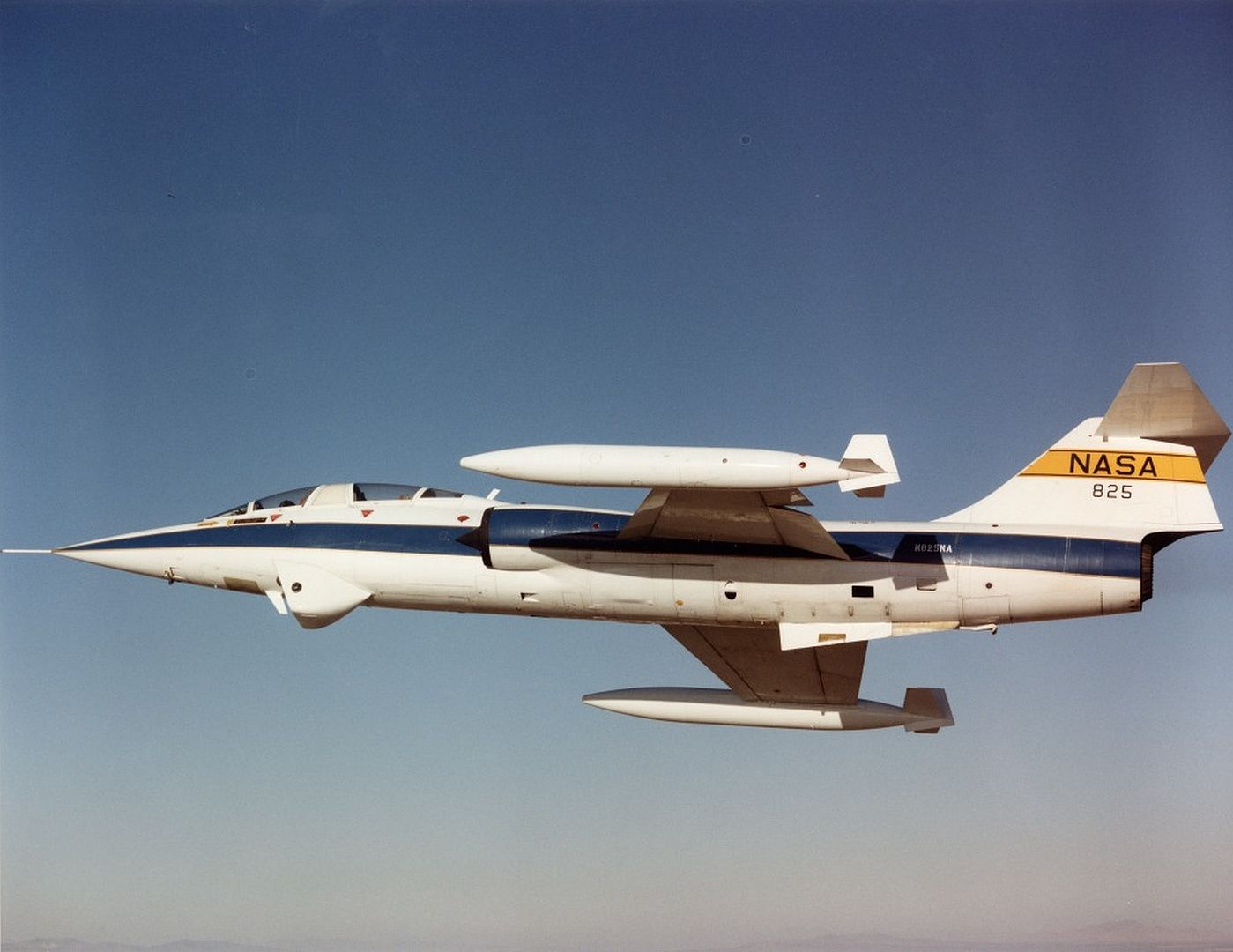
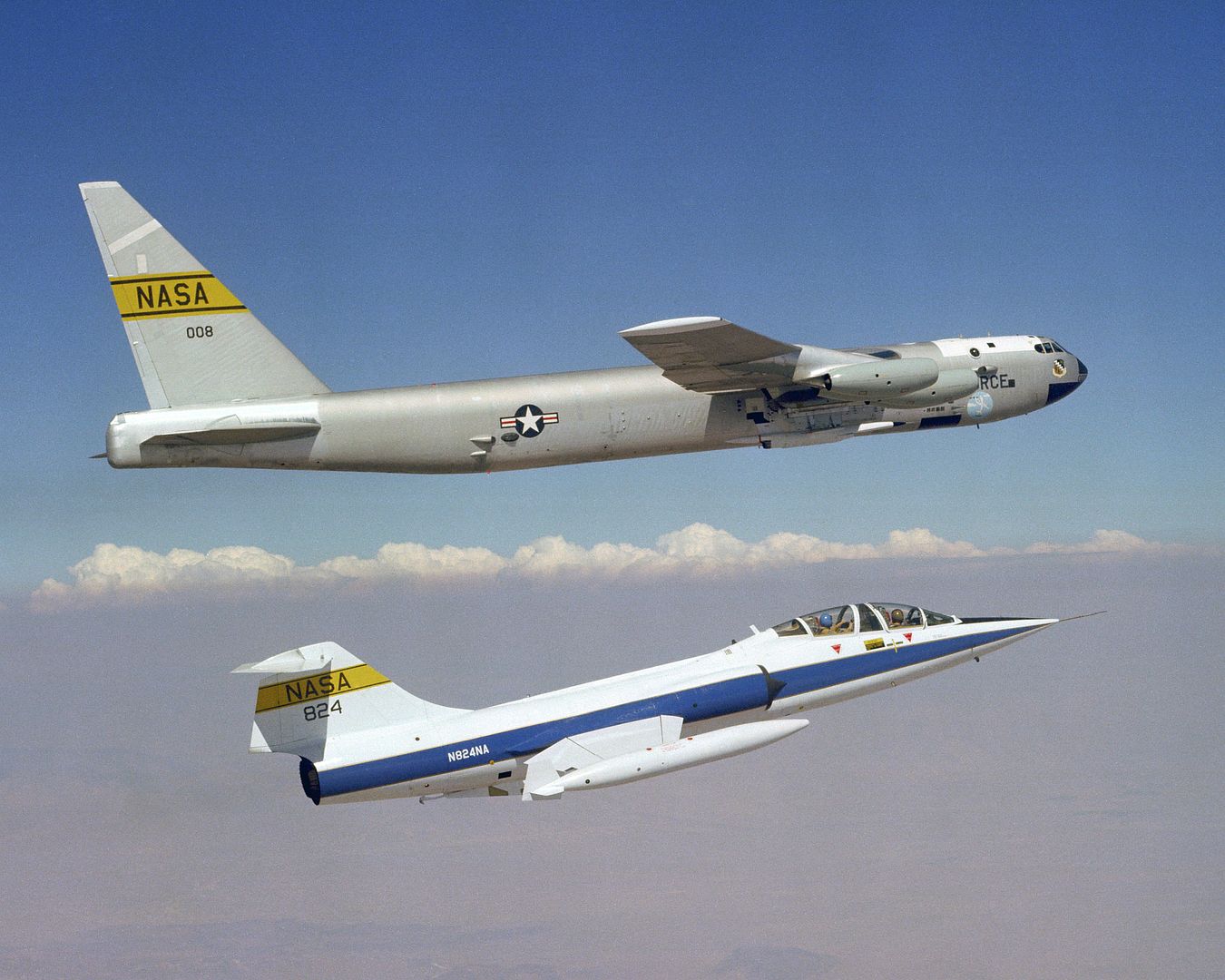
Specifications (F-104G)
General characteristics
Crew: 1
Length: 54 ft 8 in (16.66 m)
Wingspan: 21 ft 9 in (6.63 m)
Height: 13 ft 6 in (4.11 m)
Wing area: 196.1 sq ft (18.22 m2)
Airfoil: Biconvex 3.36% root and tip
Empty weight: 14,000 lb (6,350 kg)
Max takeoff weight: 29,027 lb (13,166 kg)
Powerplant: 1 ? General Electric J79 afterburning turbojet, 10,000 lbf (44 kN) thrust dry, 15,600 lbf (69 kN) with afterburner.
Performance
Maximum speed: 1,528 mph; 2,459 km/h (1,328 kn)
Maximum speed: Mach 2
Combat range: 420 mi (365 nmi; 676 km)
Ferry range: 1,630 mi (1,416 nmi; 2,623 km)
Service ceiling: 50,000 ft (15,000 m)
Rate of climb: 48,000 ft/min (240 m/s) Initially
Lift-to-drag: 9.2
Wing loading: 105 lb/sq ft (510 kg/m2)
Thrust/weight: 0.54 with max. takeoff weight (0.76 loaded)
Armament
Guns: 1 ? 20 mm (0.787 in) M61A1 Vulcan 6-barreled Gatling cannon, 725 rounds
Hardpoints: 7 with a capacity of 4,000 lb (1,800 kg),with provisions to carry combinations of:
Missiles: 4 ? AIM-9 Sidewinder
Other: Bombs, rockets, or other stores
Most of the text from here Thanks as usual LINK -- http://www.airvectors.net/avf104_1.html
Post a reply
- Go to Previous topic
- Go to Next topic
- Go to Welcome
- Go to Introduce Yourself
- Go to General Discussion
- Go to Screenshots, Images and Videos
- Go to Off topic
- Go to Works in Progress
- Go to Skinning Tips / Tutorials
- Go to Skin Requests
- Go to IJAAF Library
- Go to Luftwaffe Library
- Go to RAF Library
- Go to USAAF / USN Library
- Go to Misc Library
- Go to The Ops Room
- Go to Made in Germany
- Go to Campaigns and Missions
- Go to Works in Progress
- Go to Juri's Air-Raid Shelter
- Go to Campaigns and Missions
- Go to Works in Progress
- Go to Skinpacks
- Go to External Projects Discussion
- Go to Books & Resources
